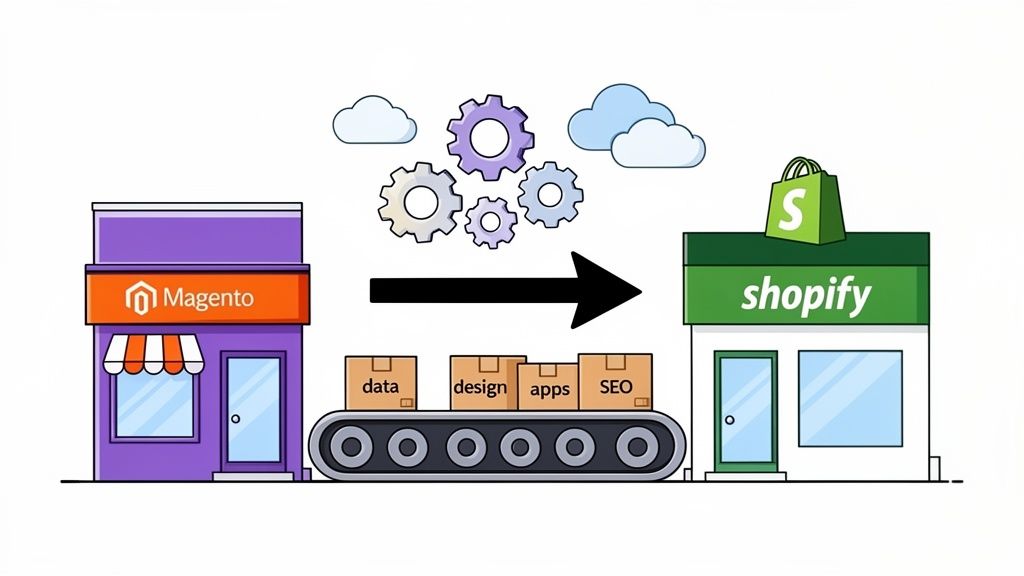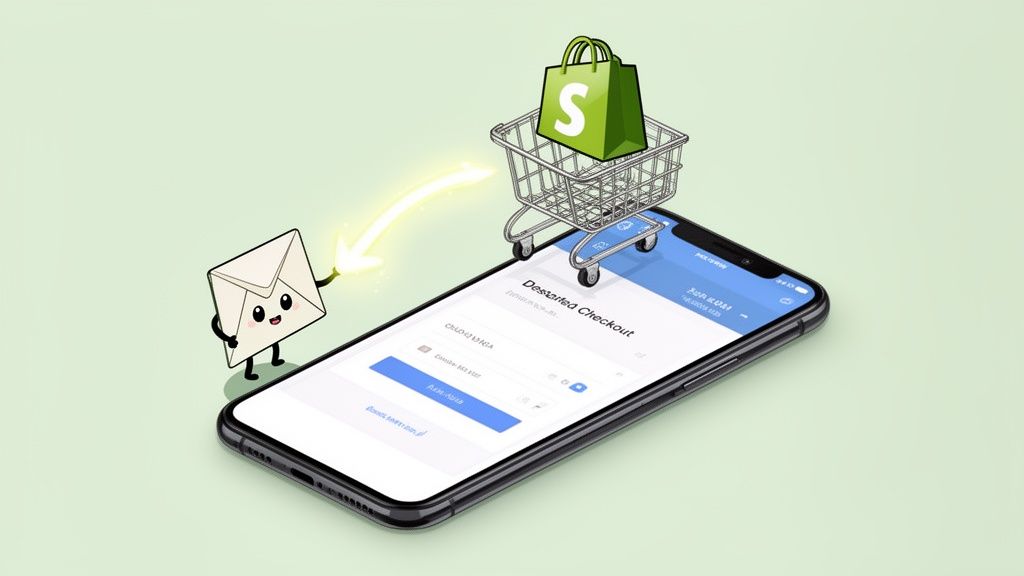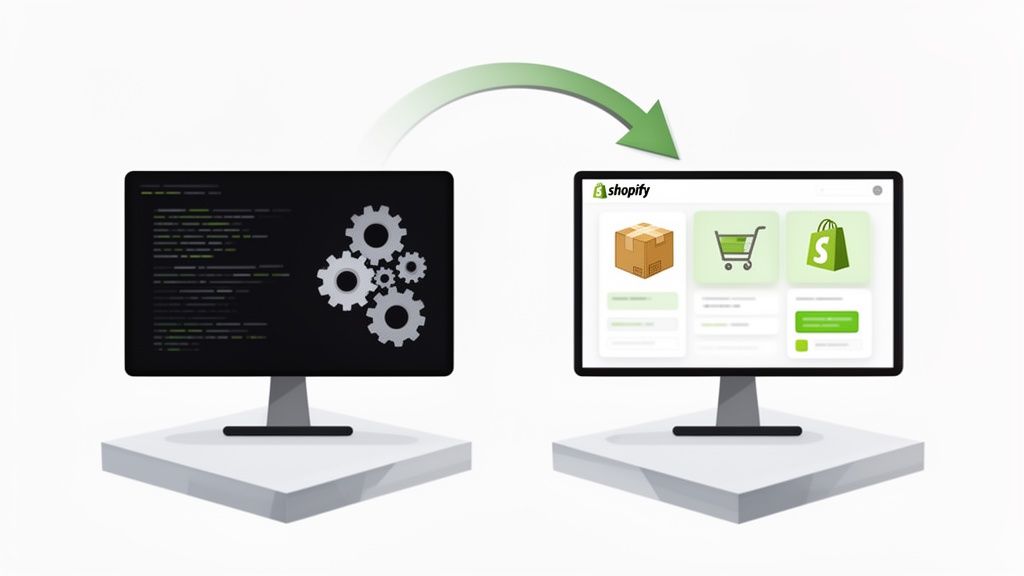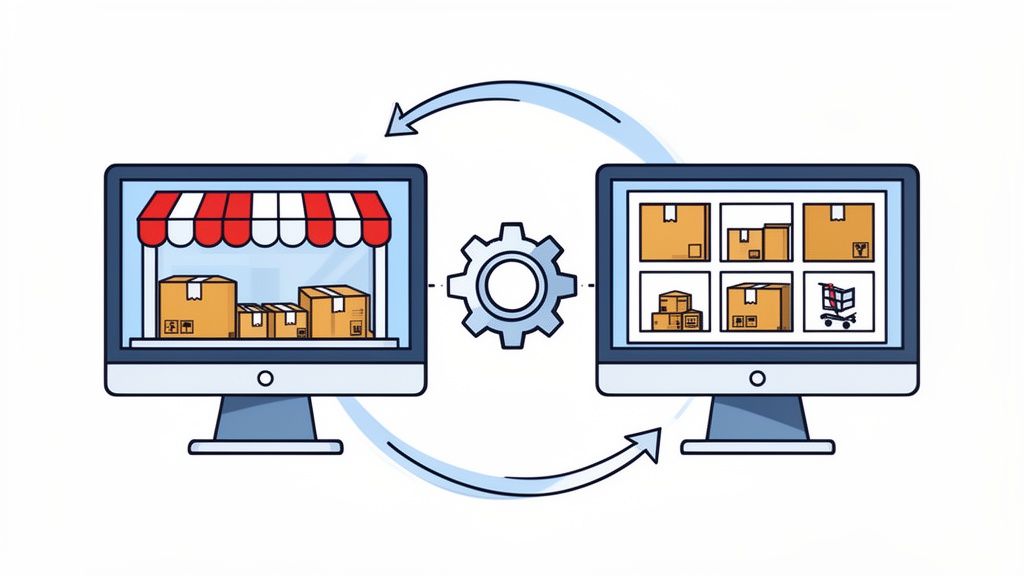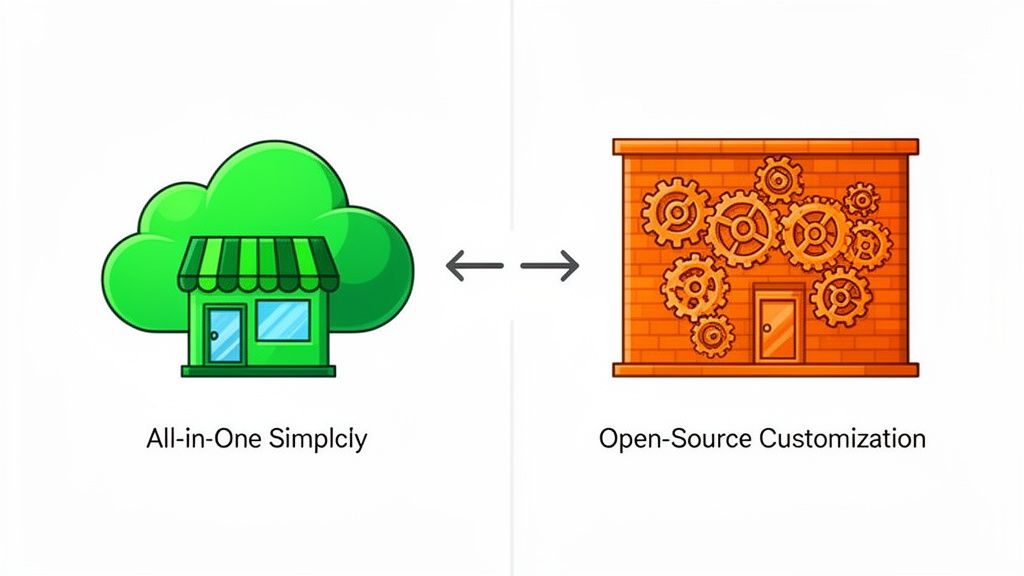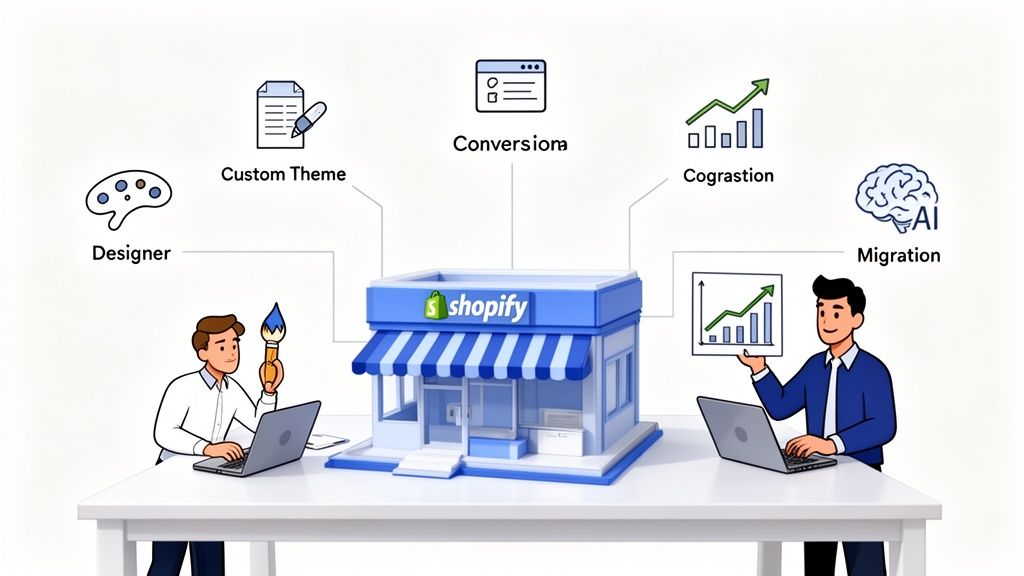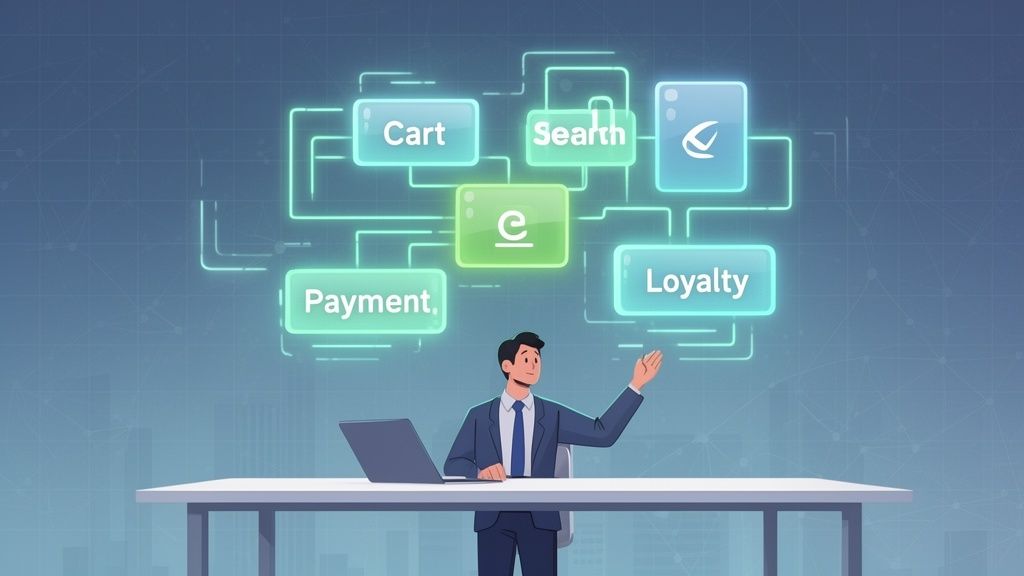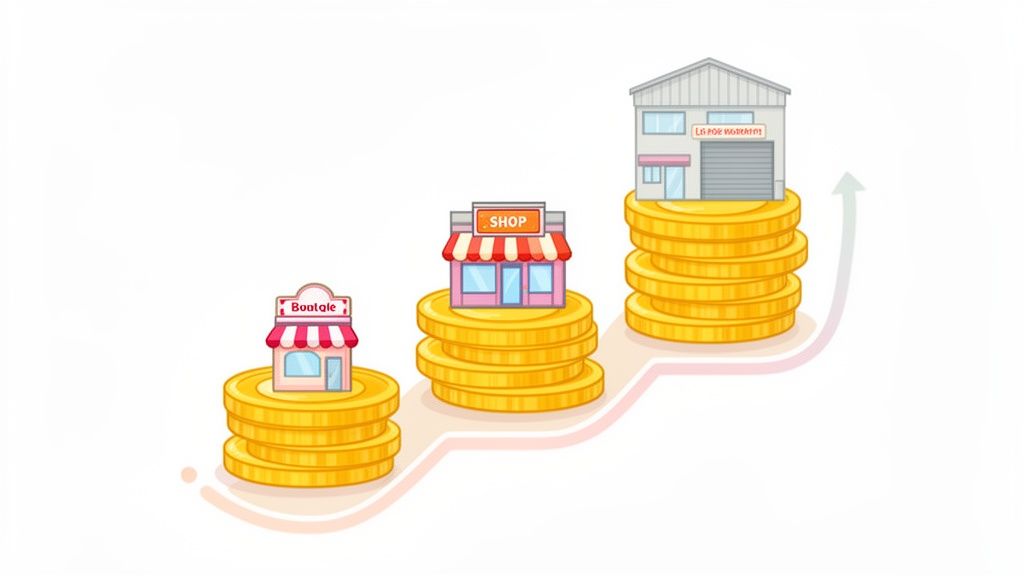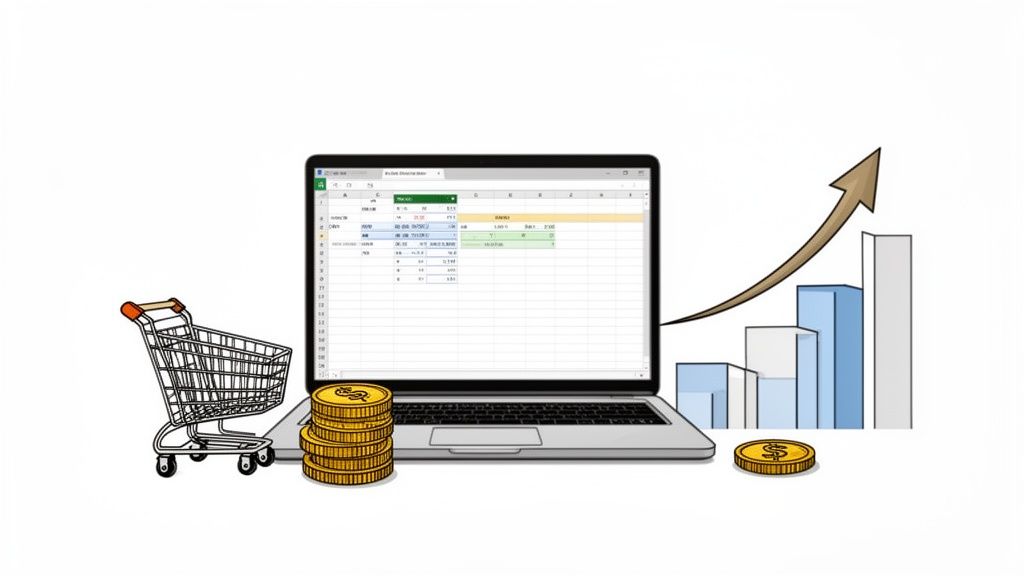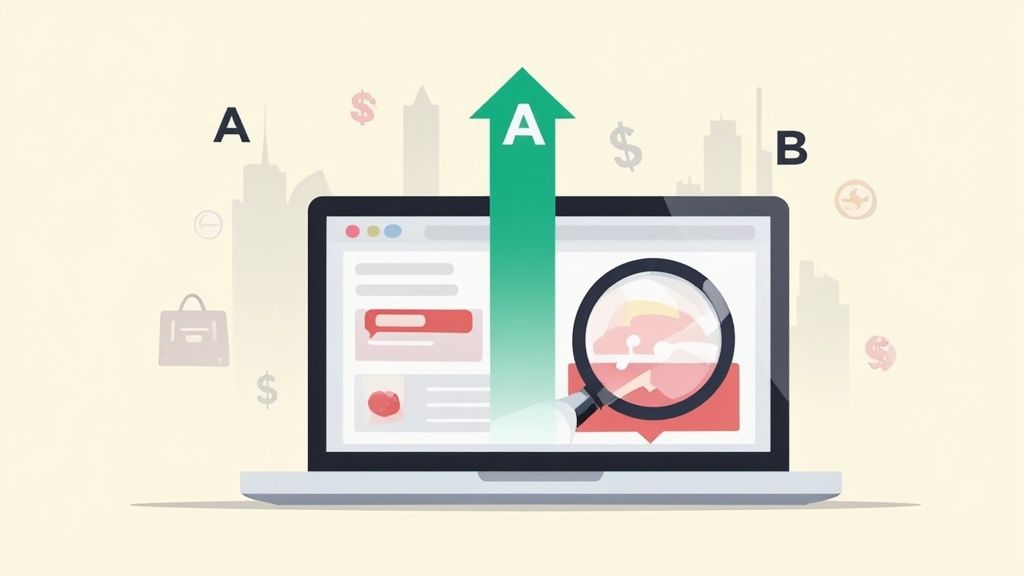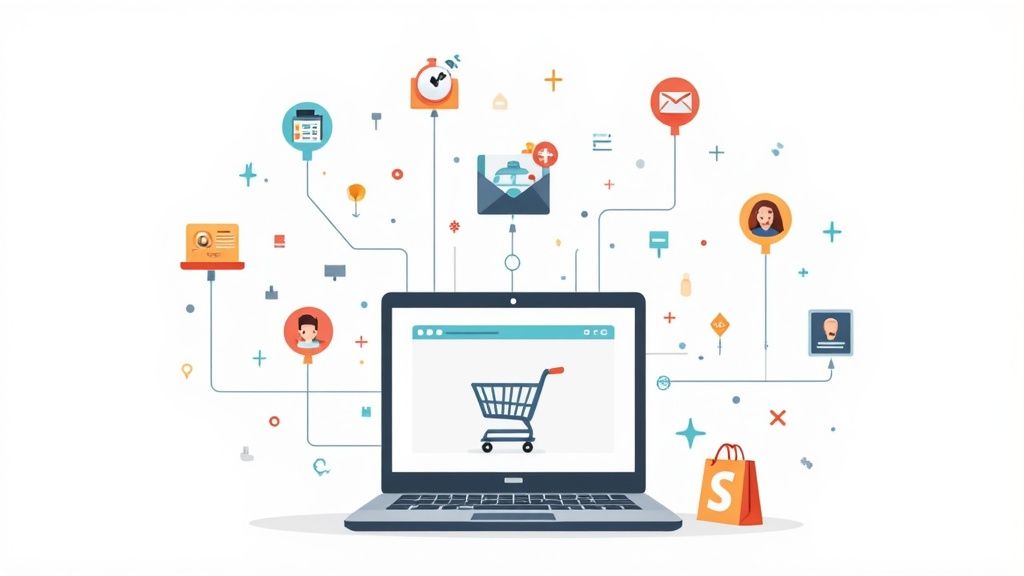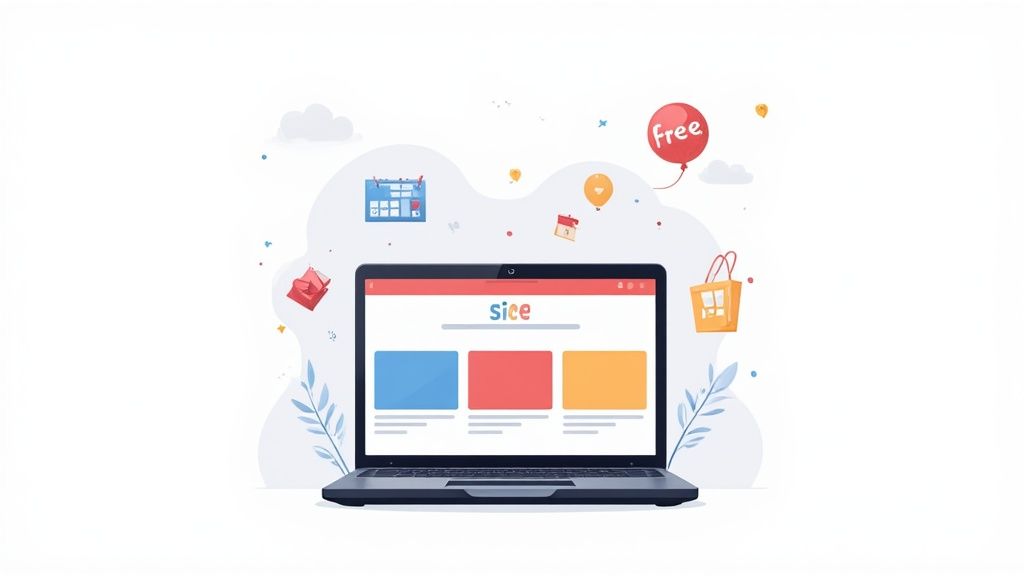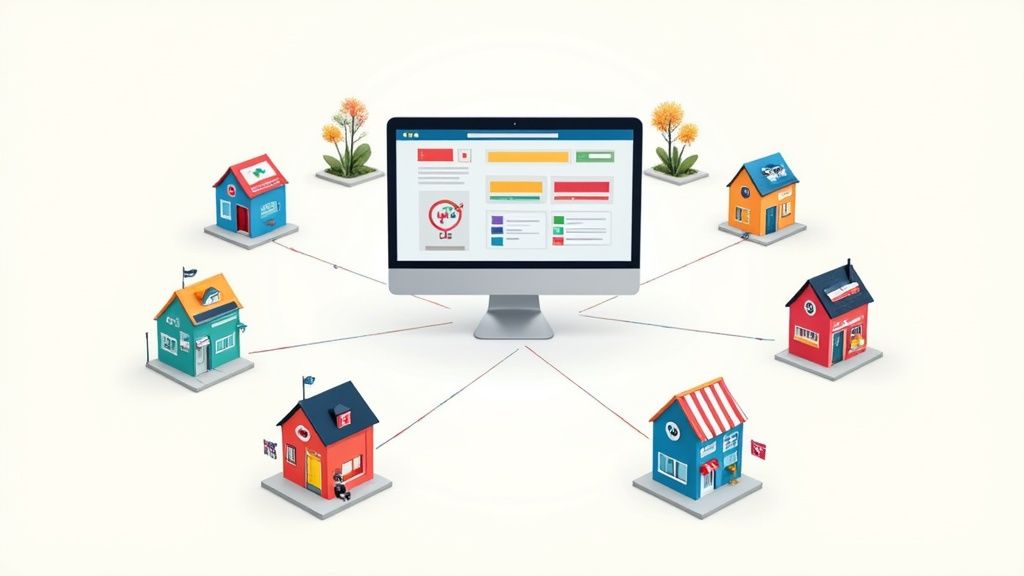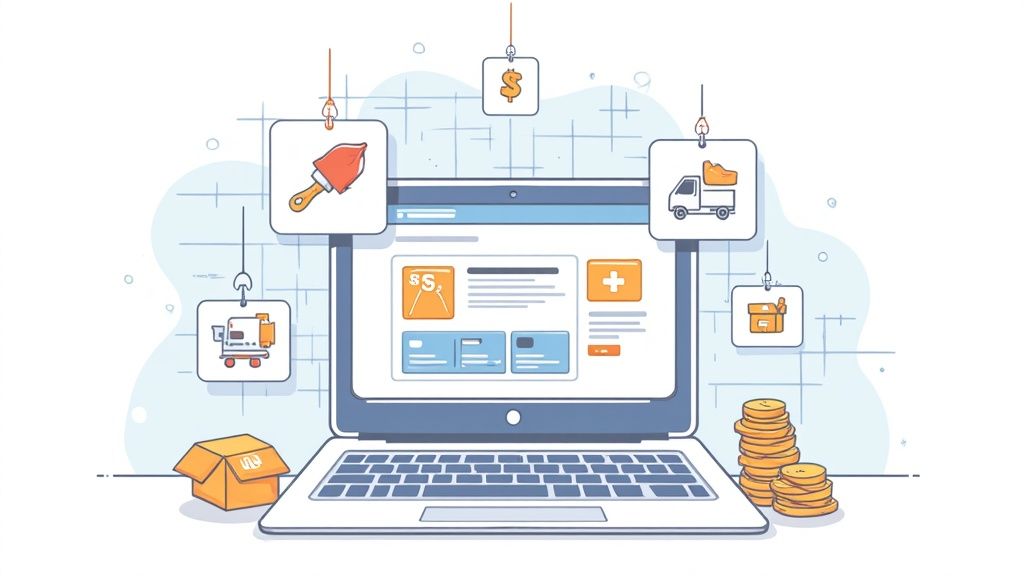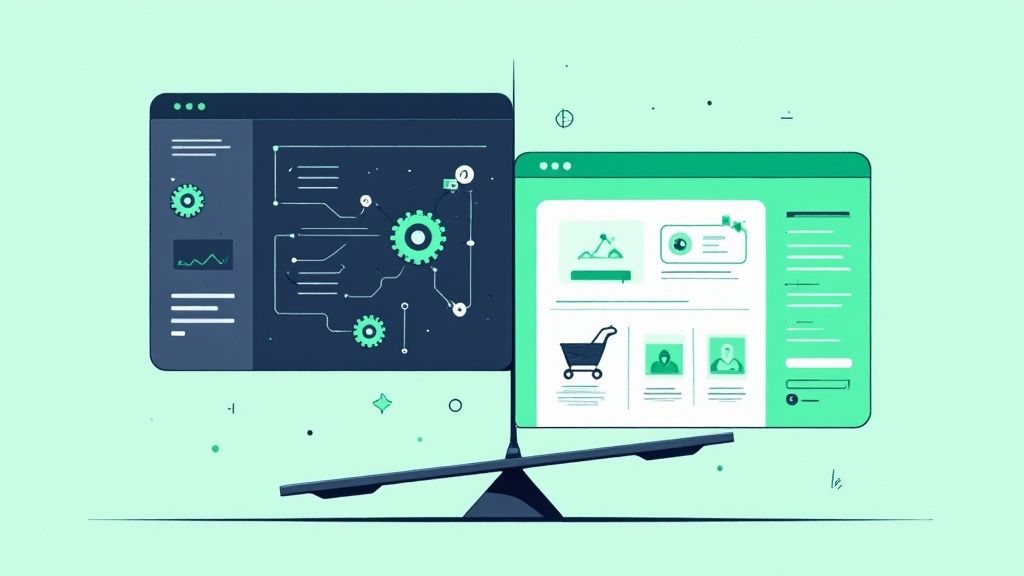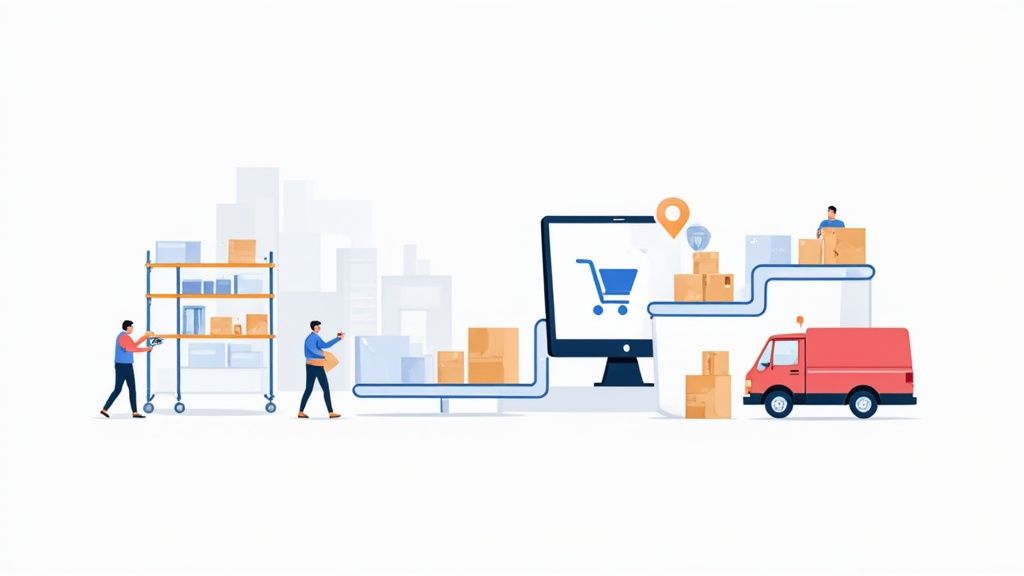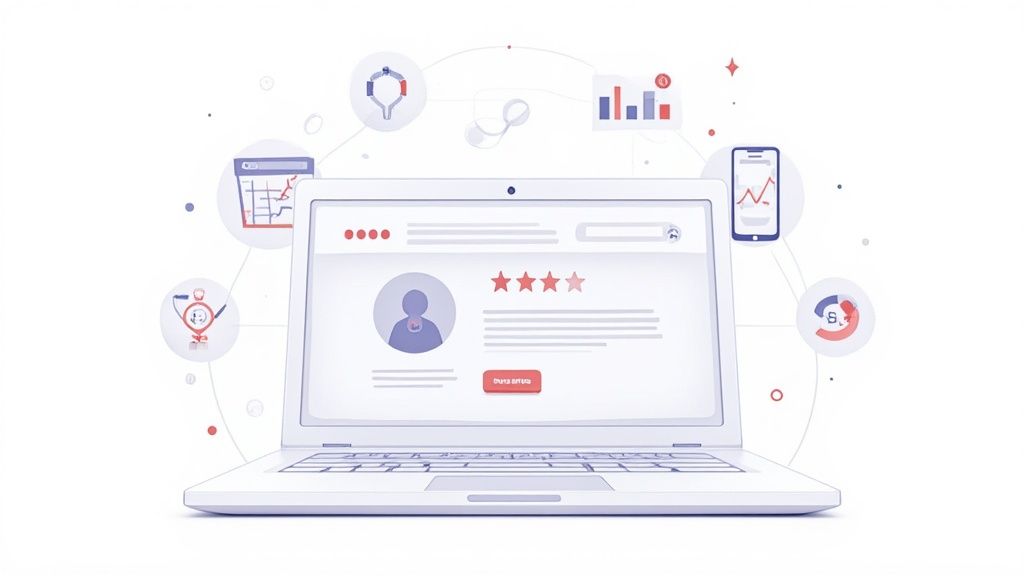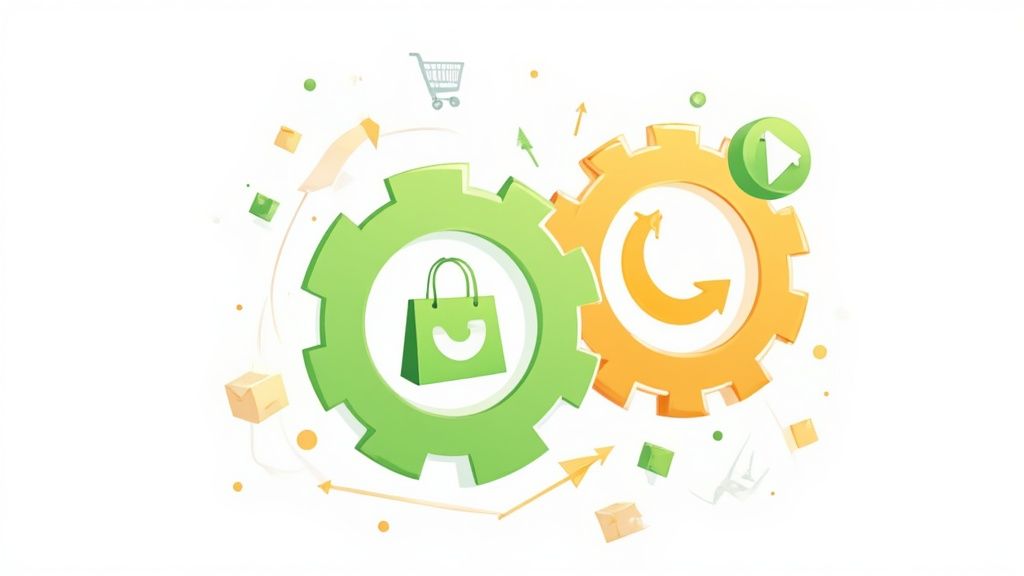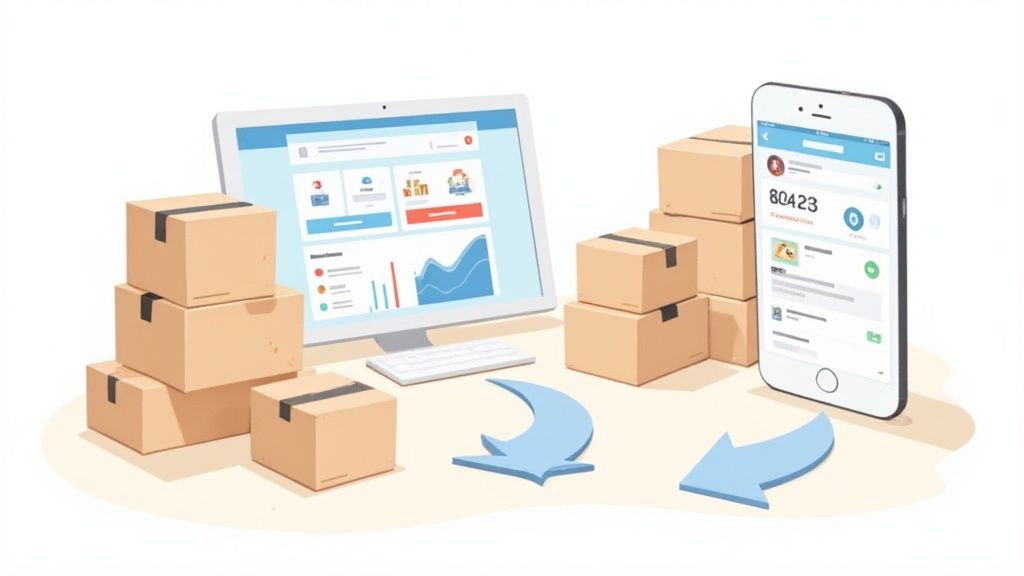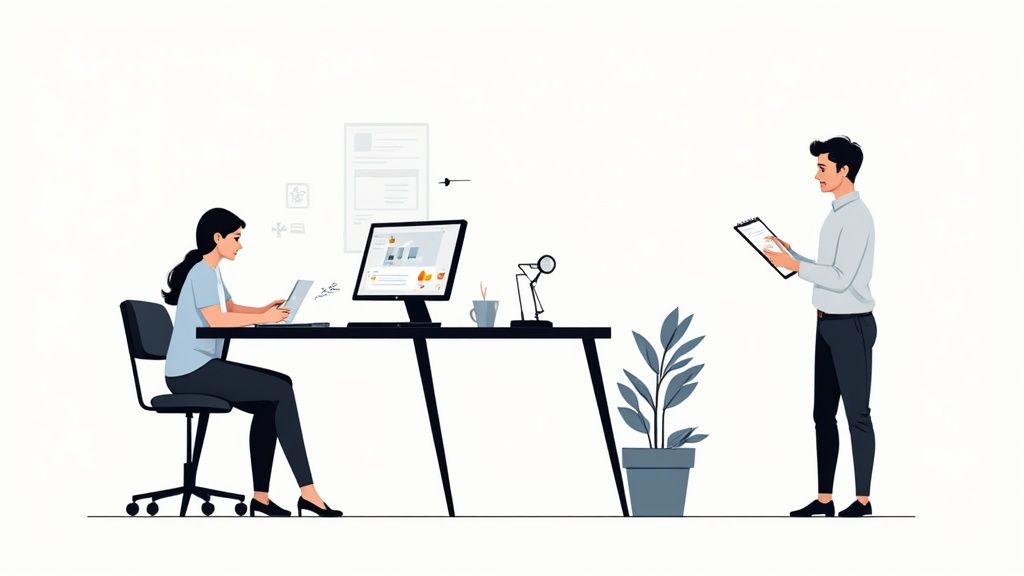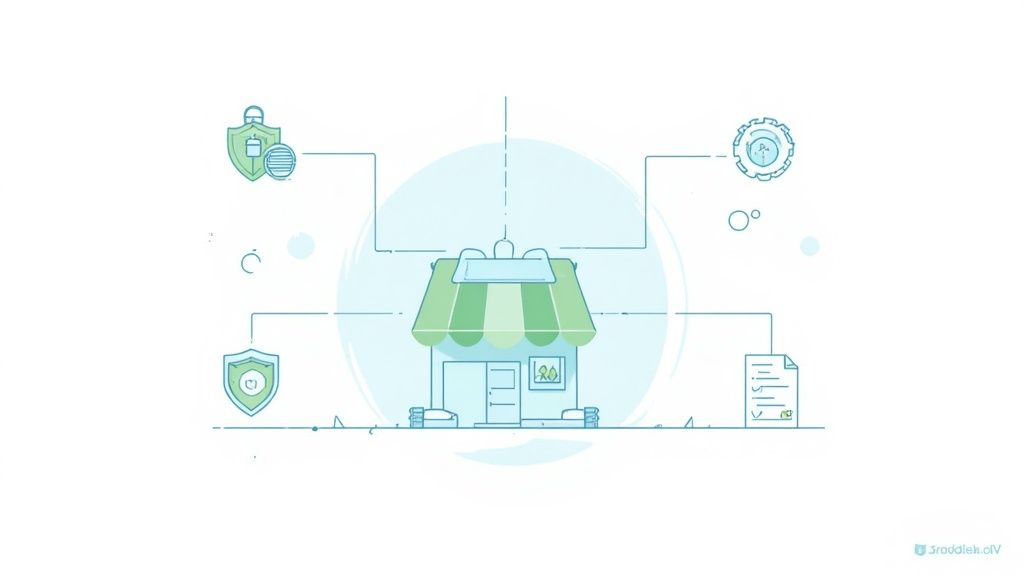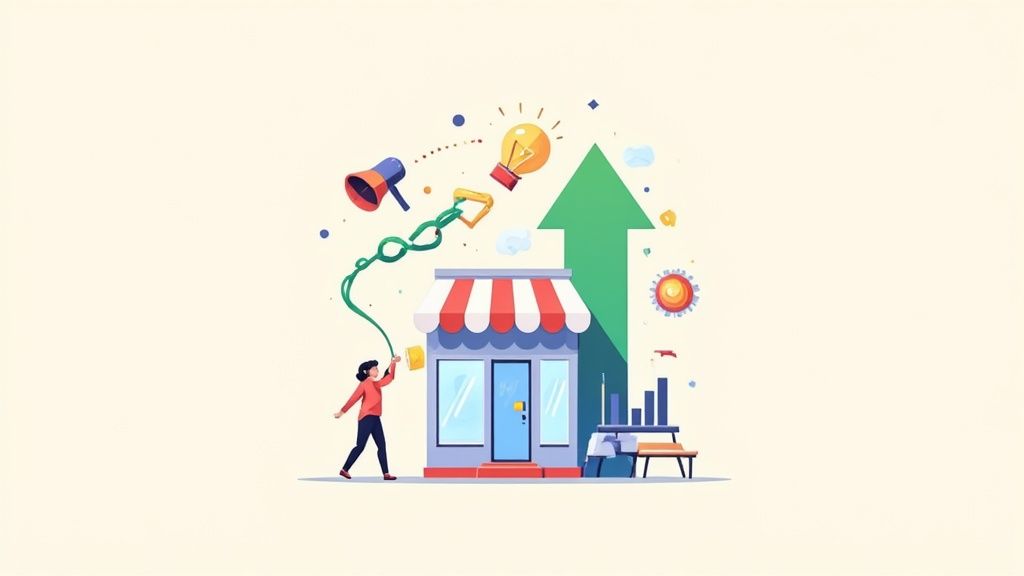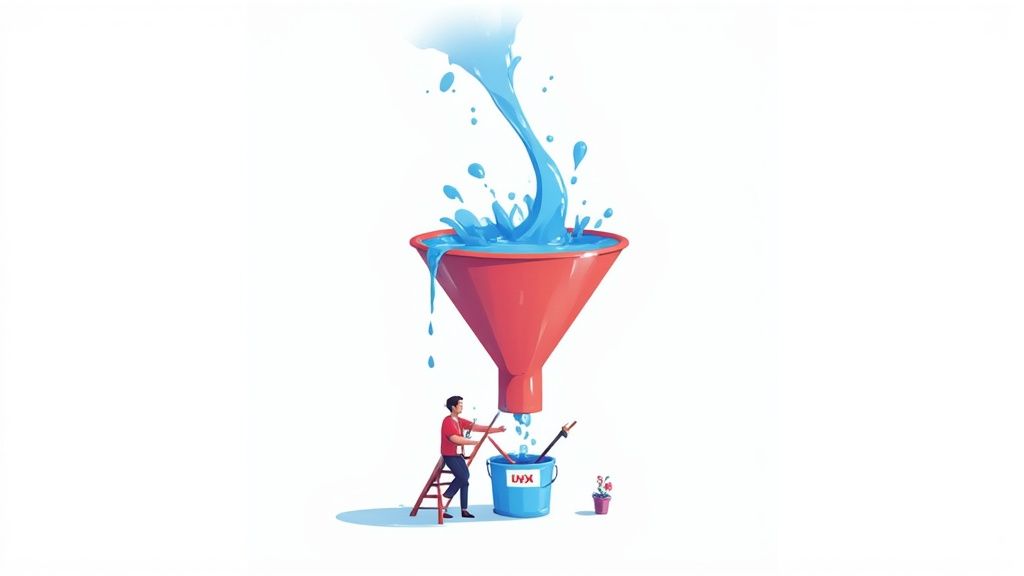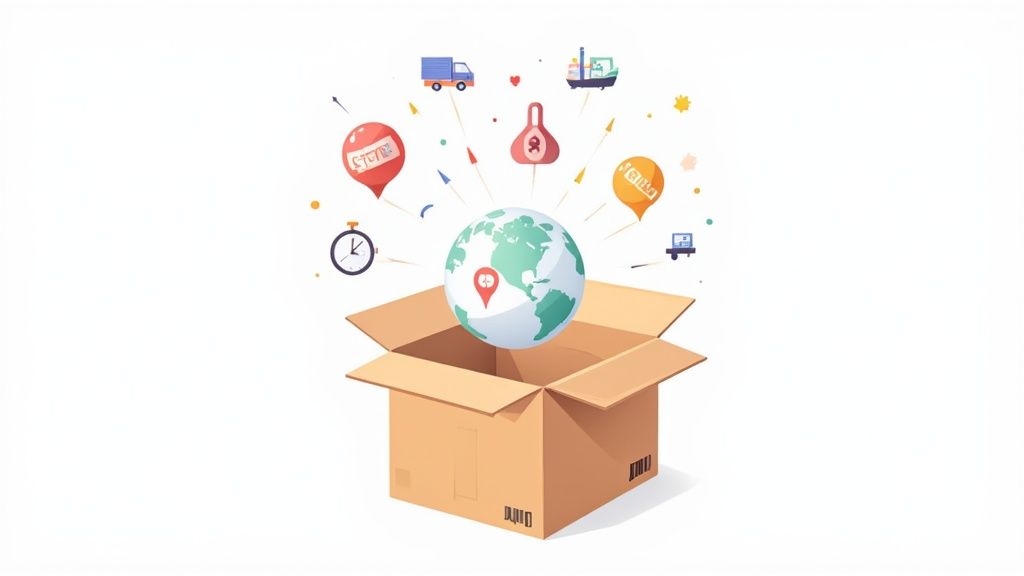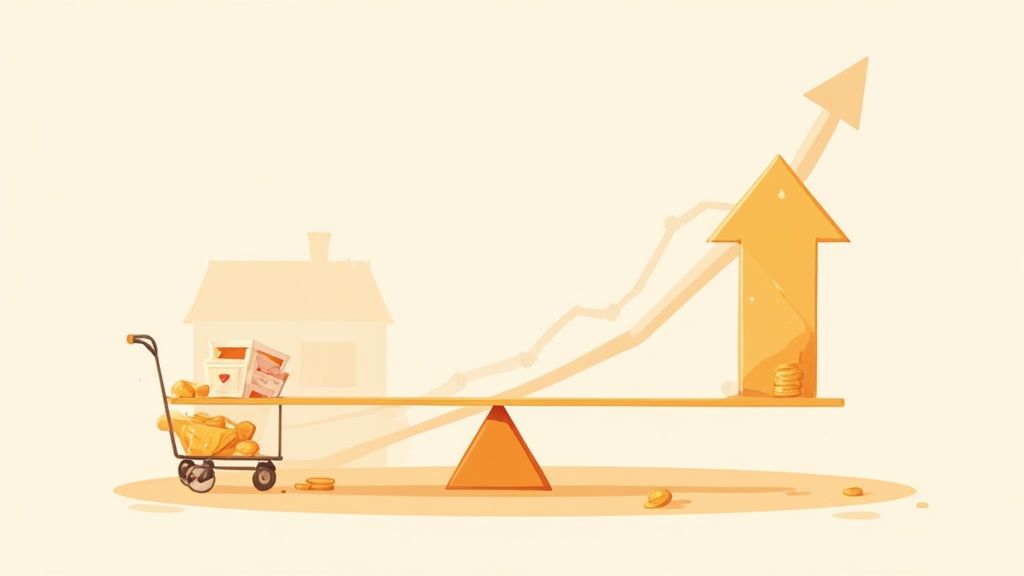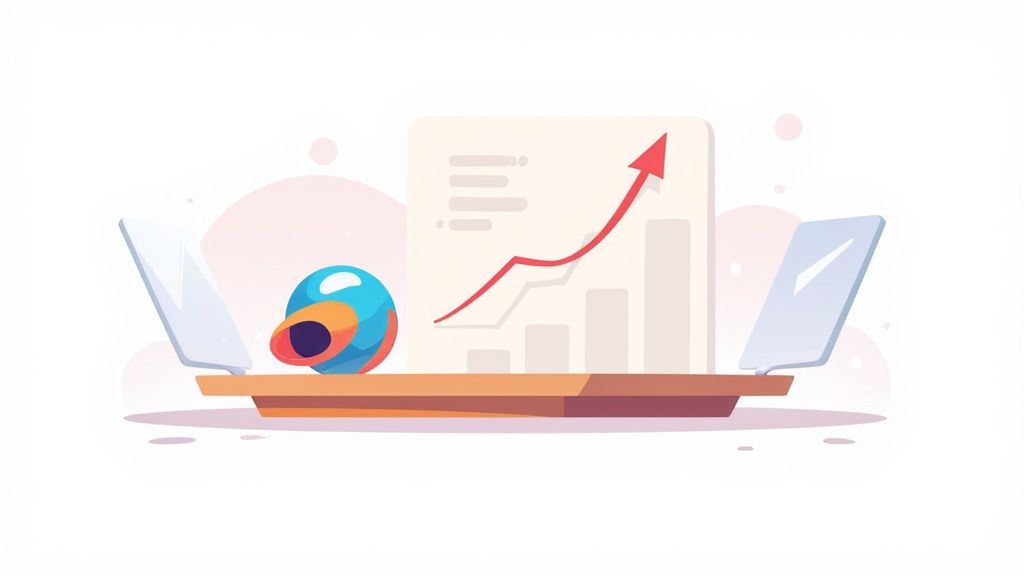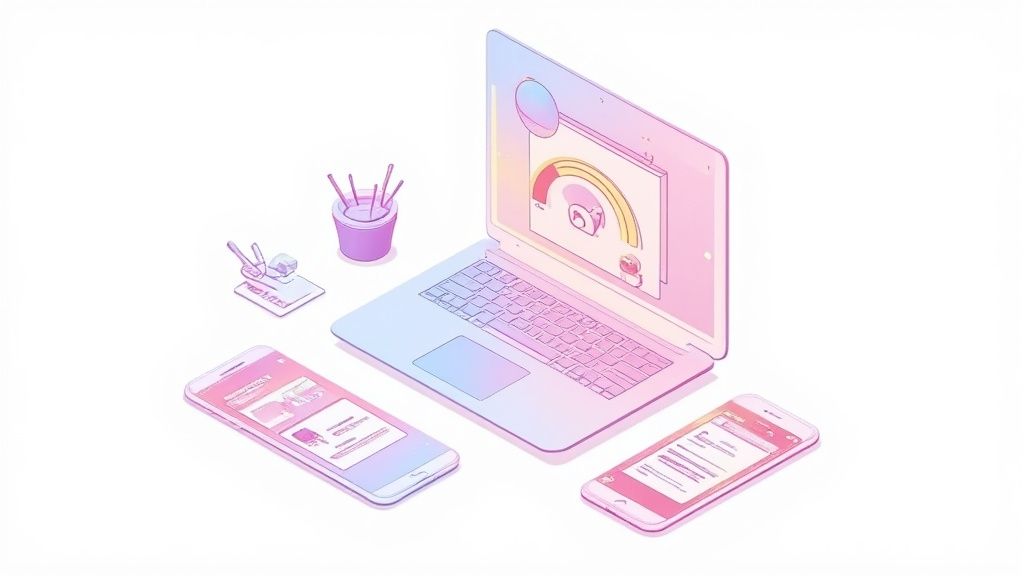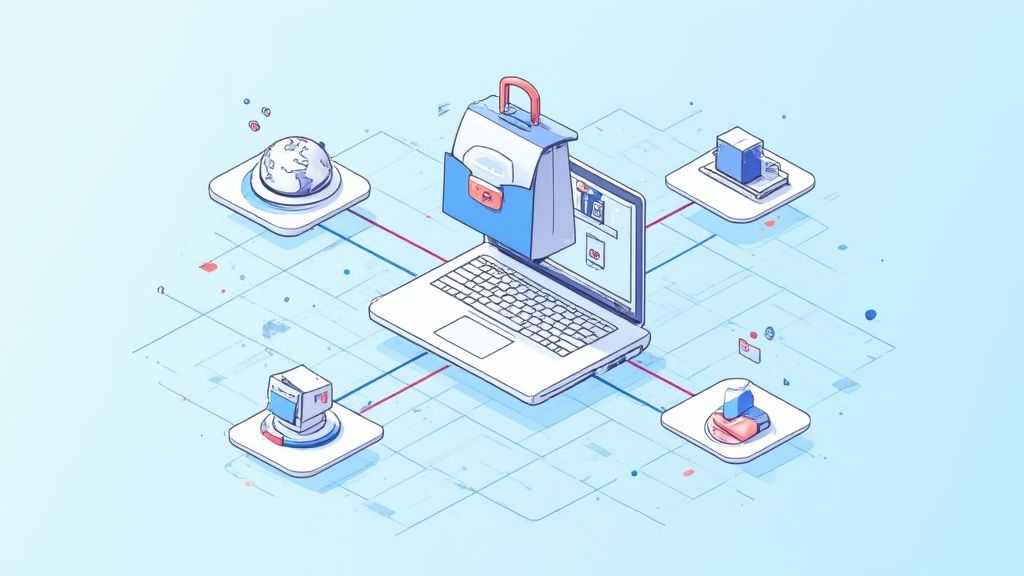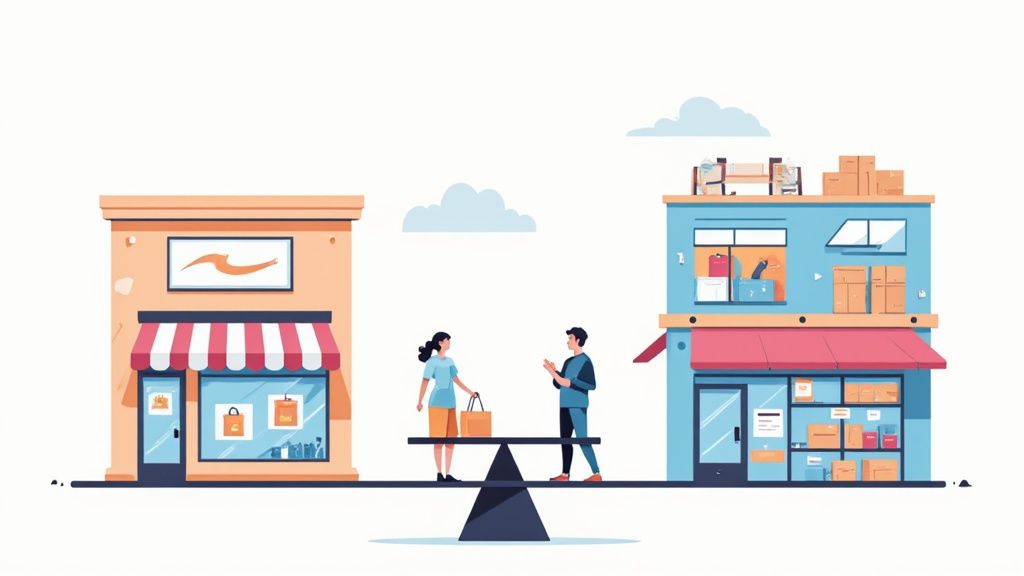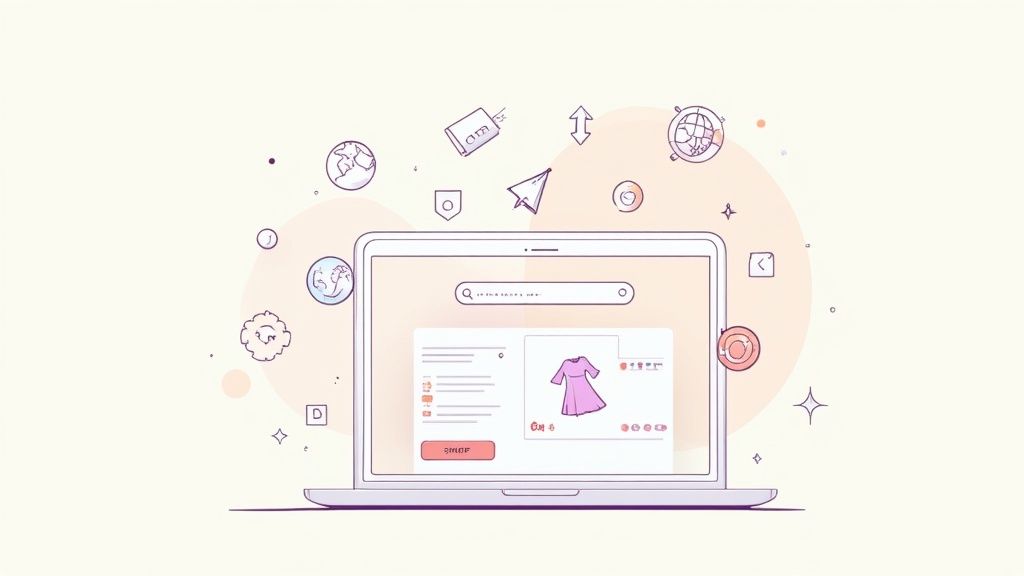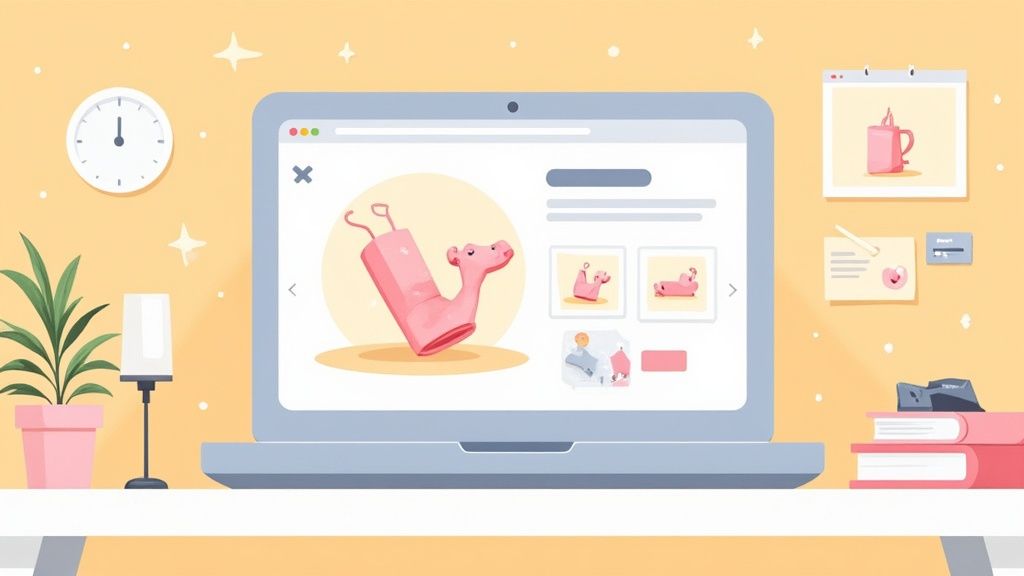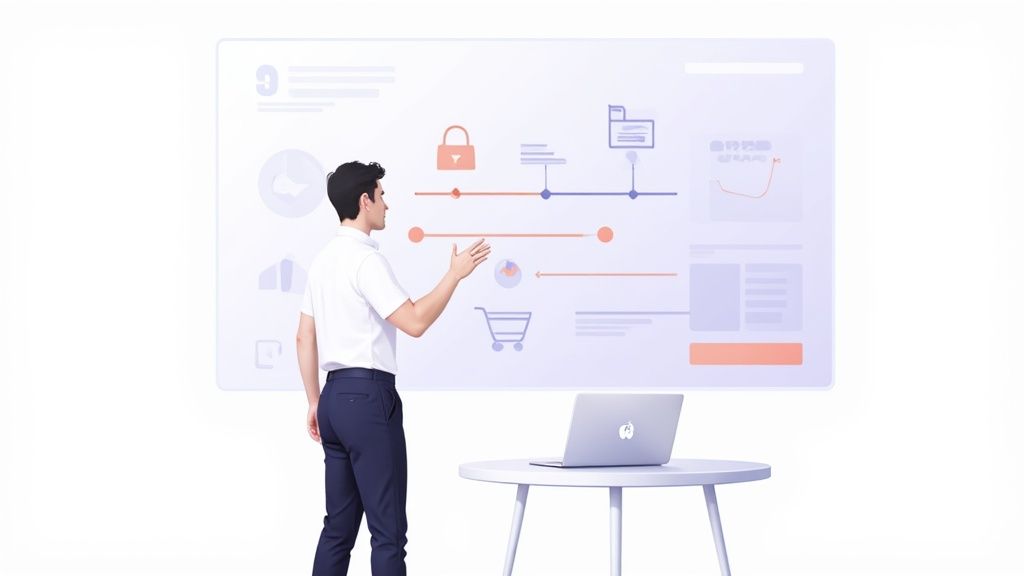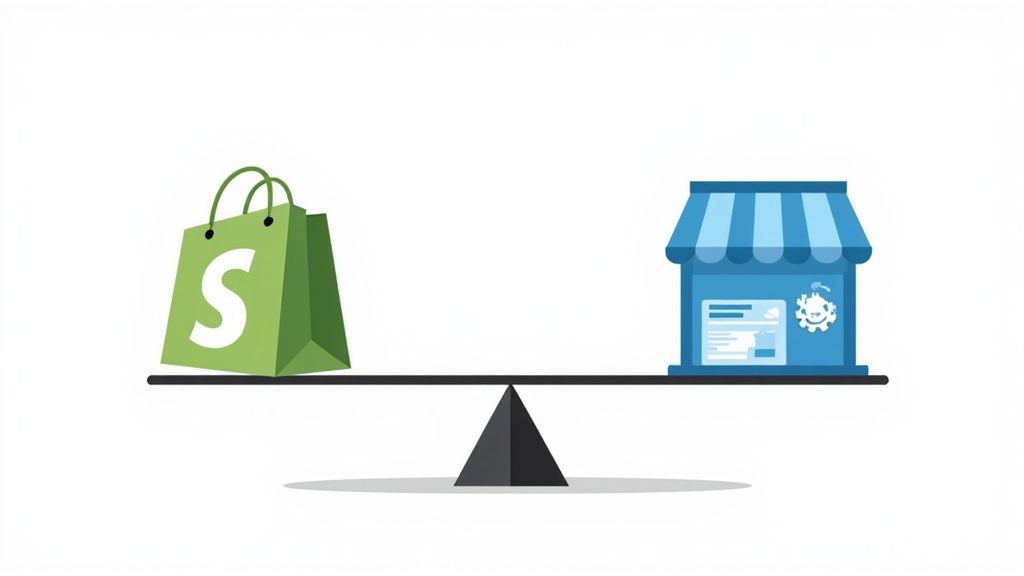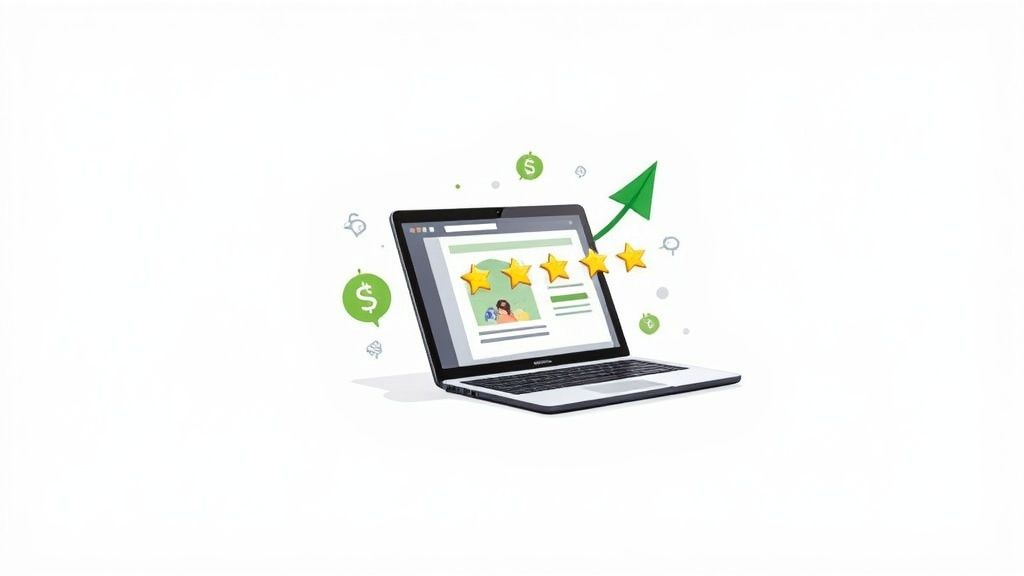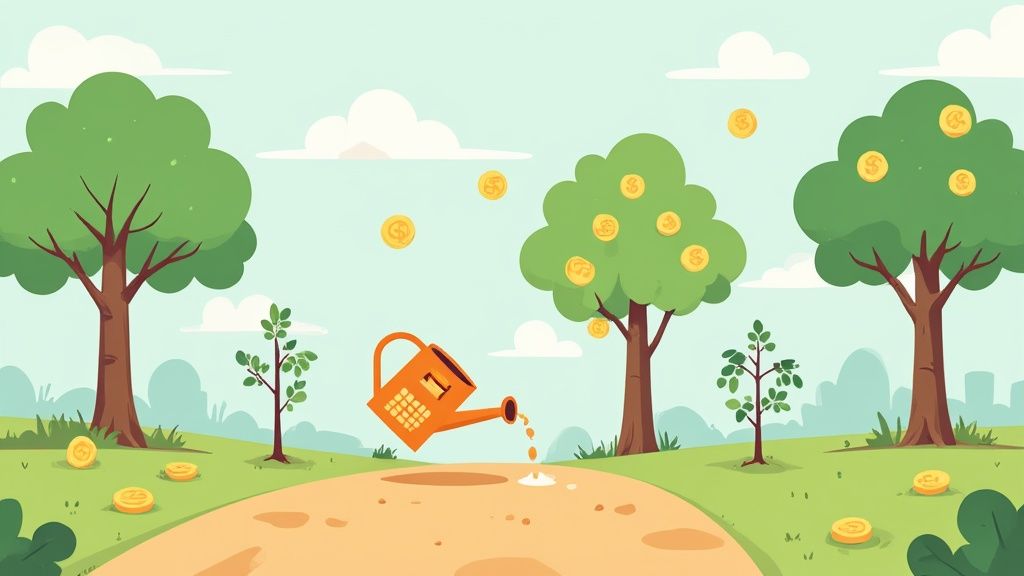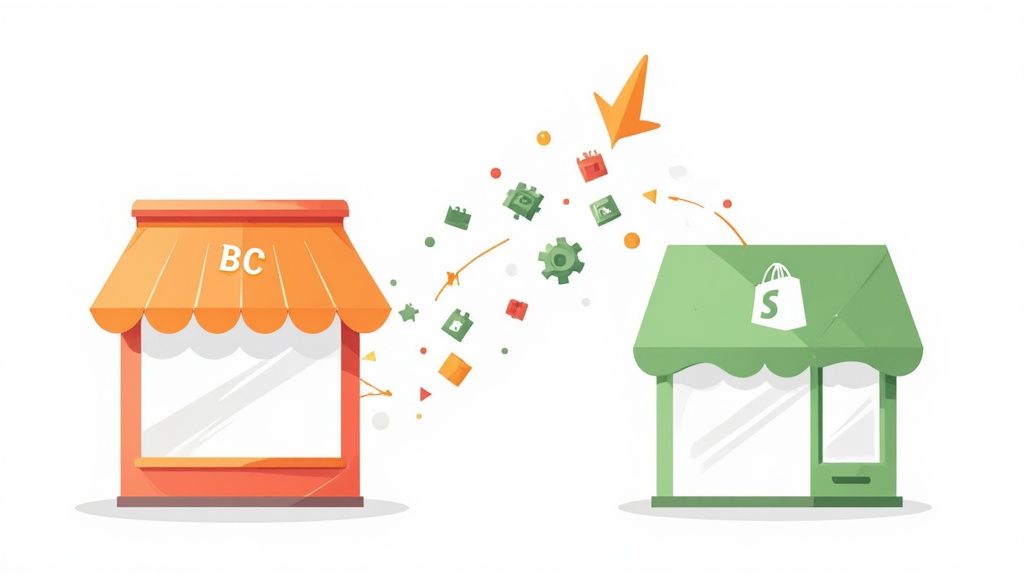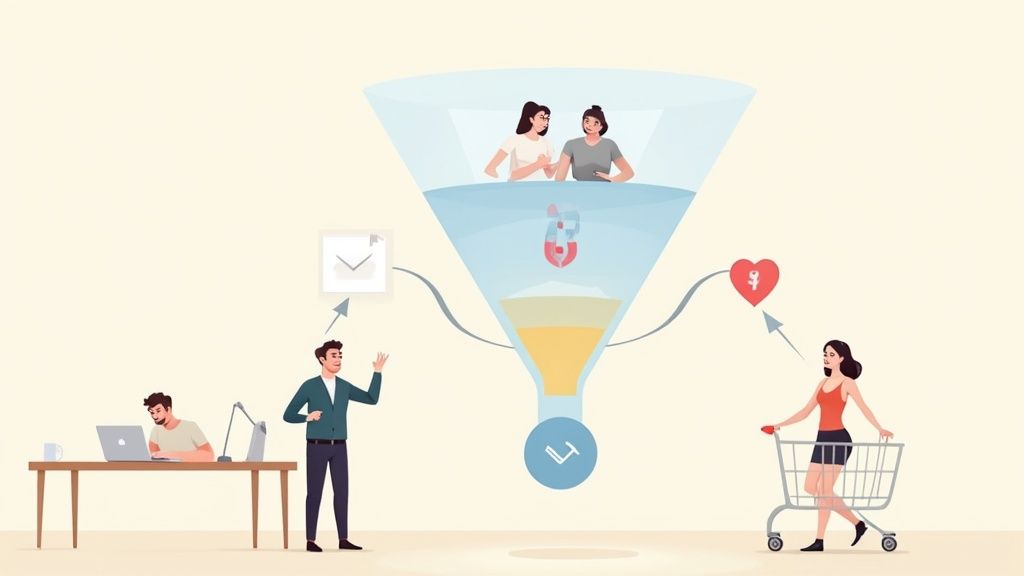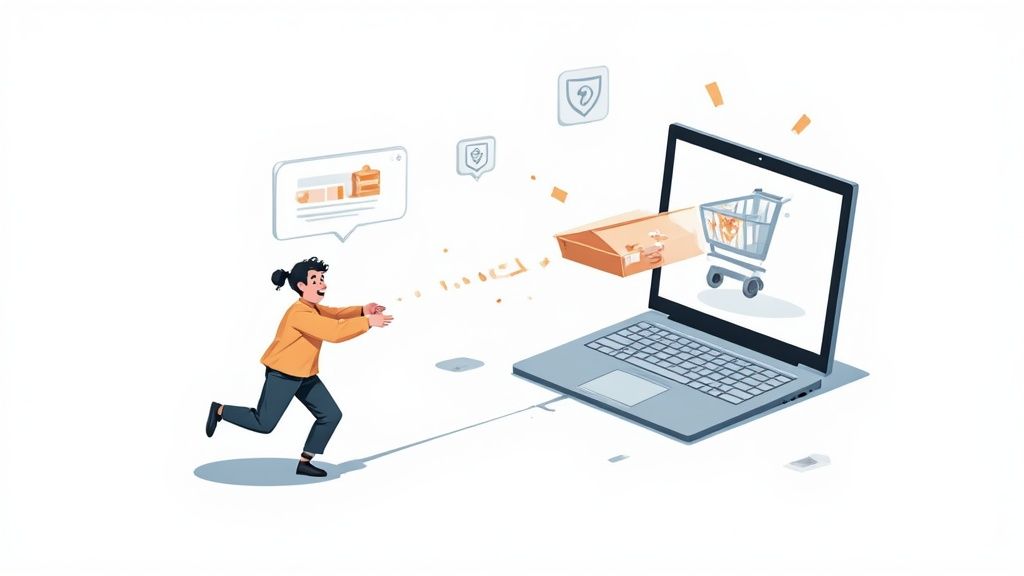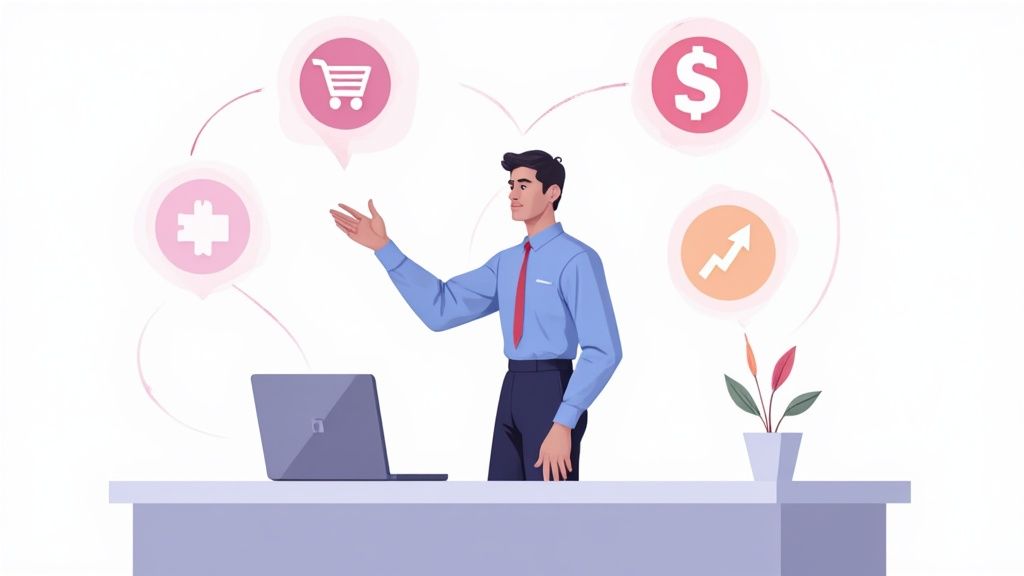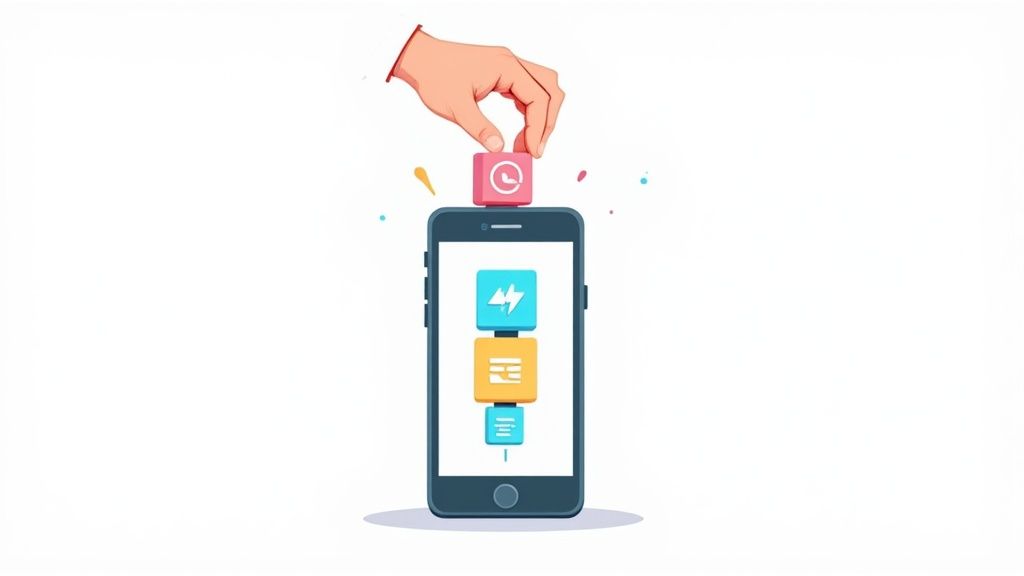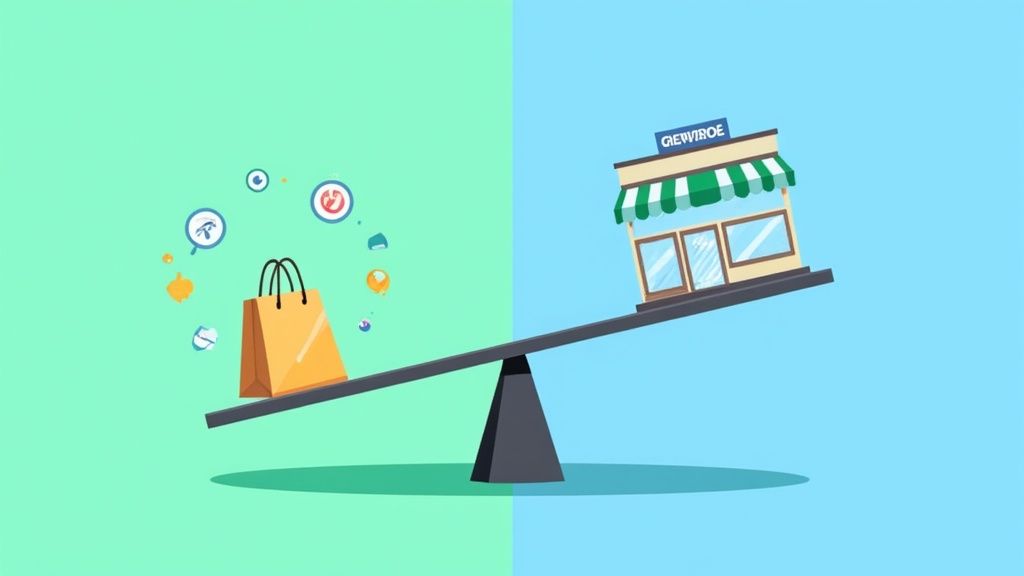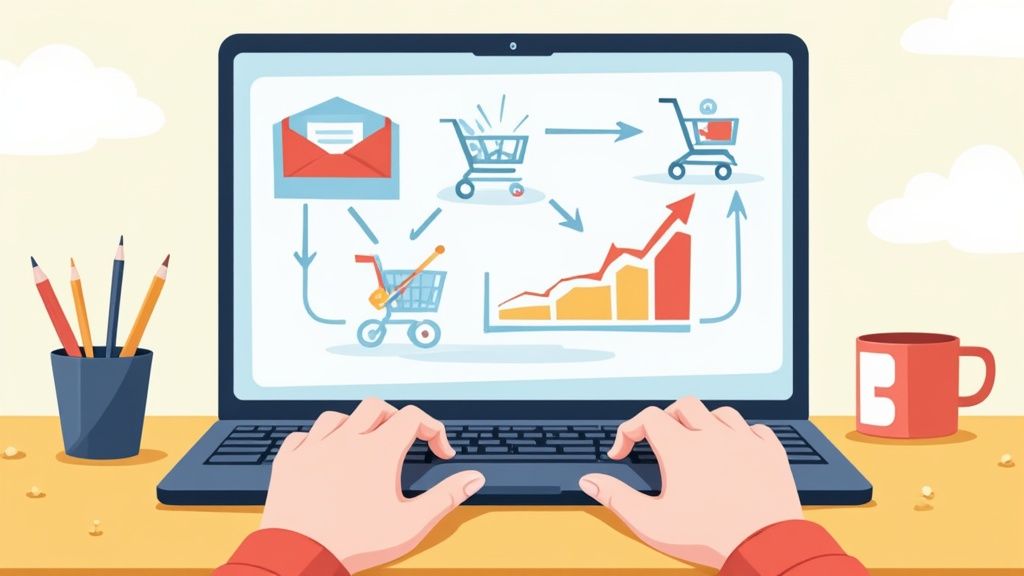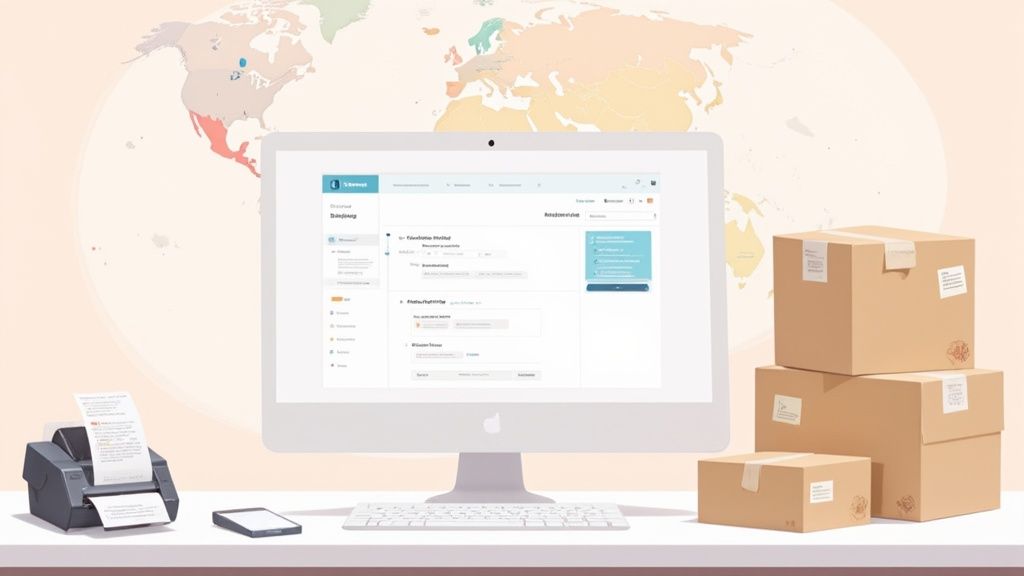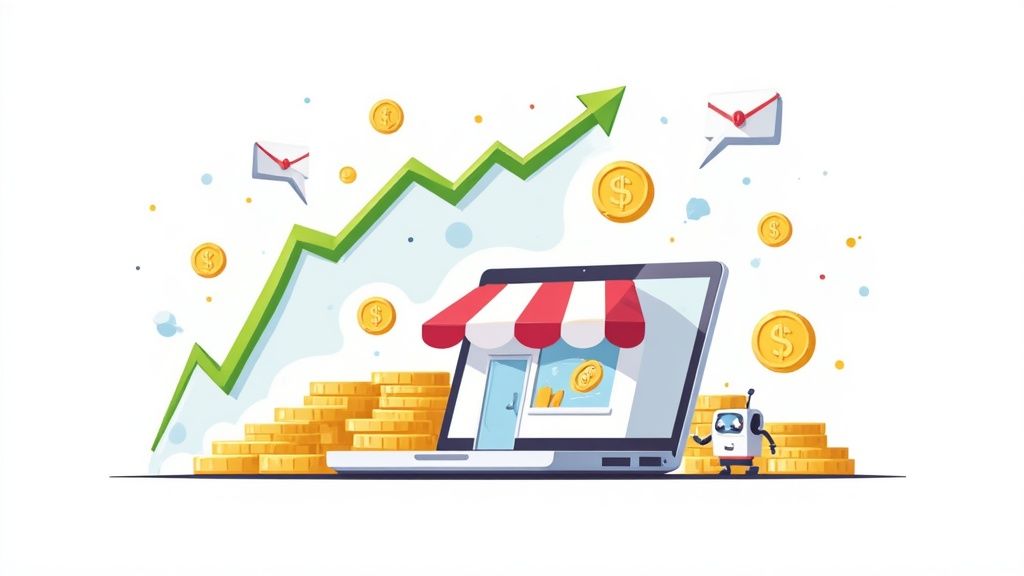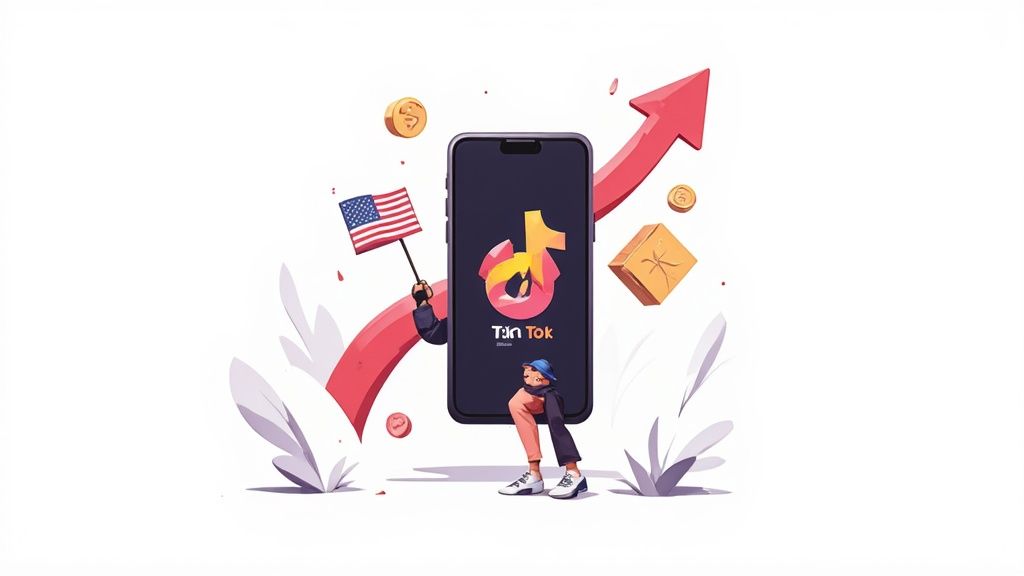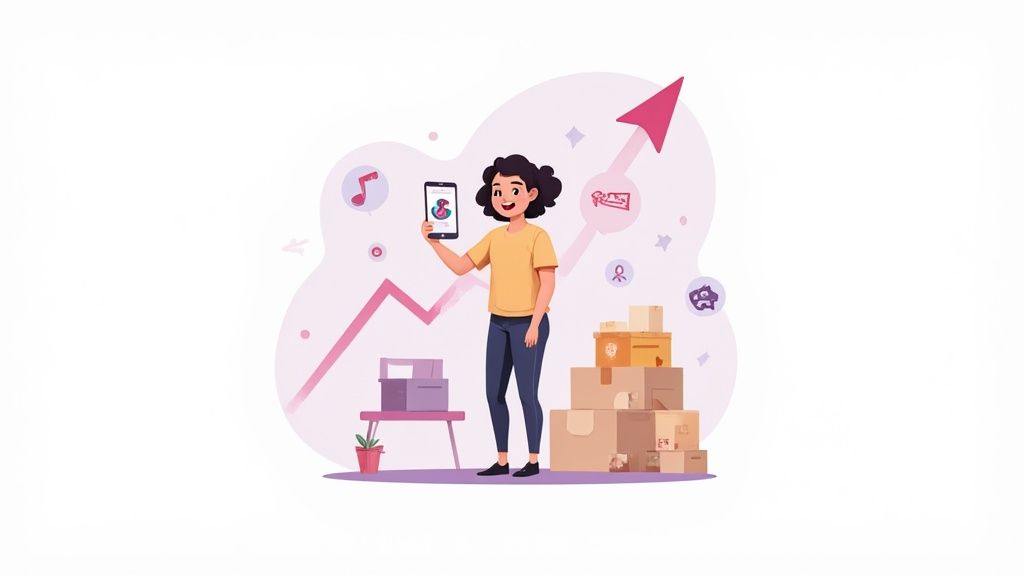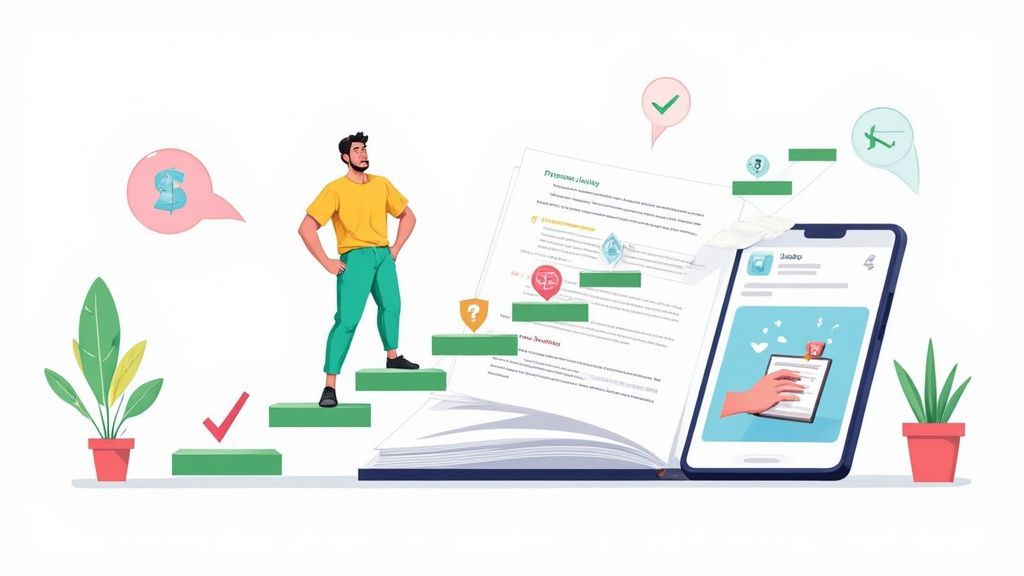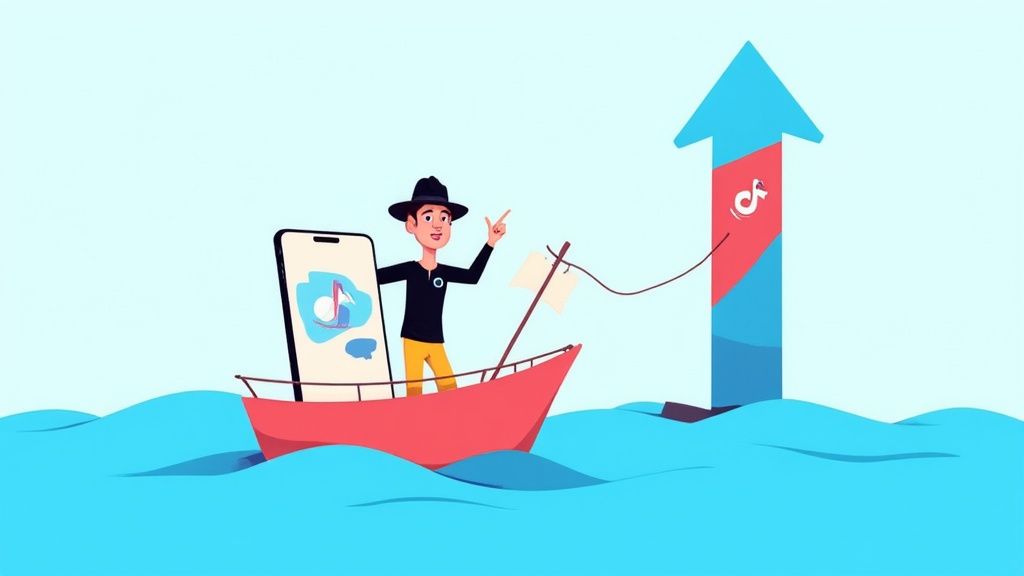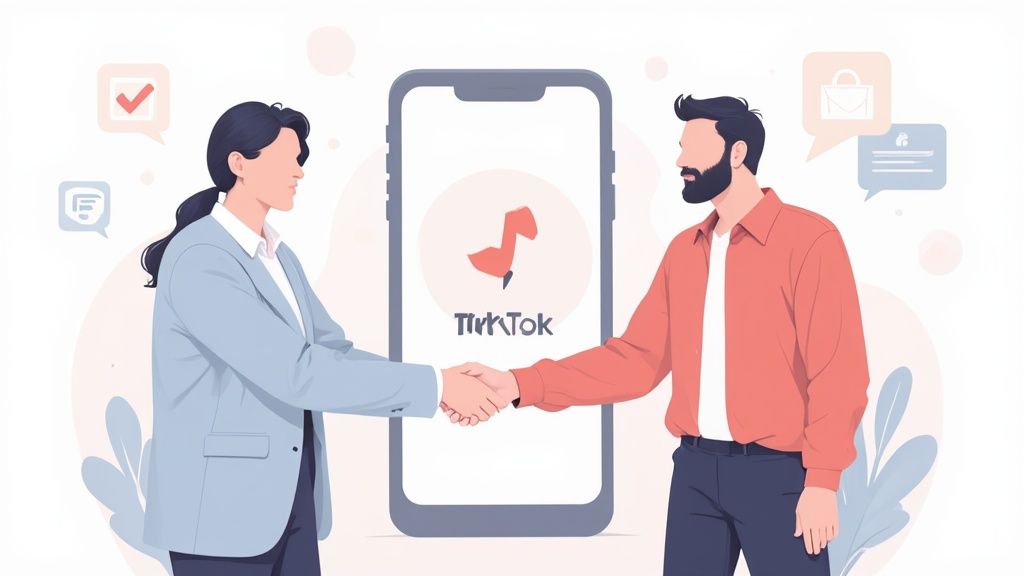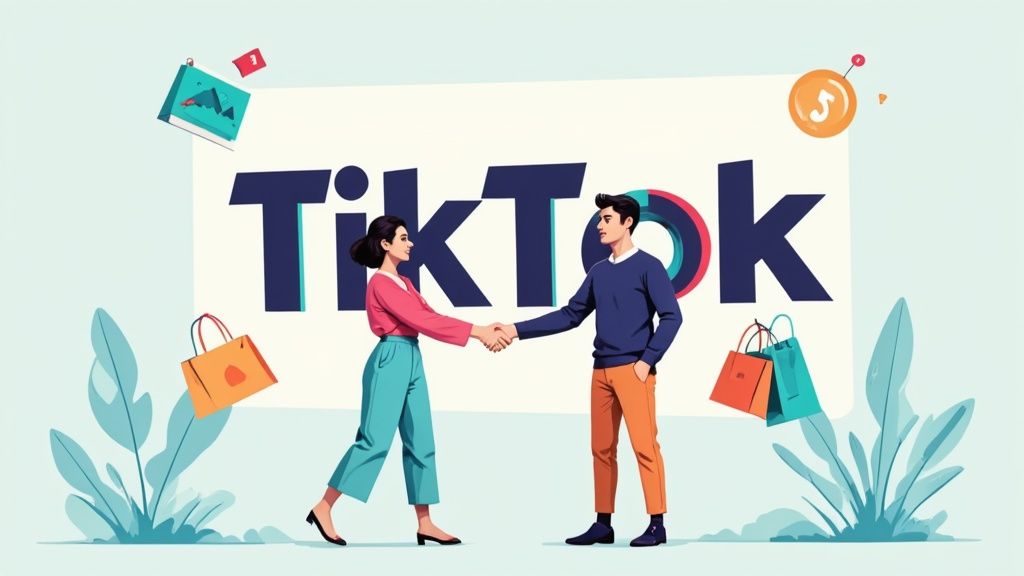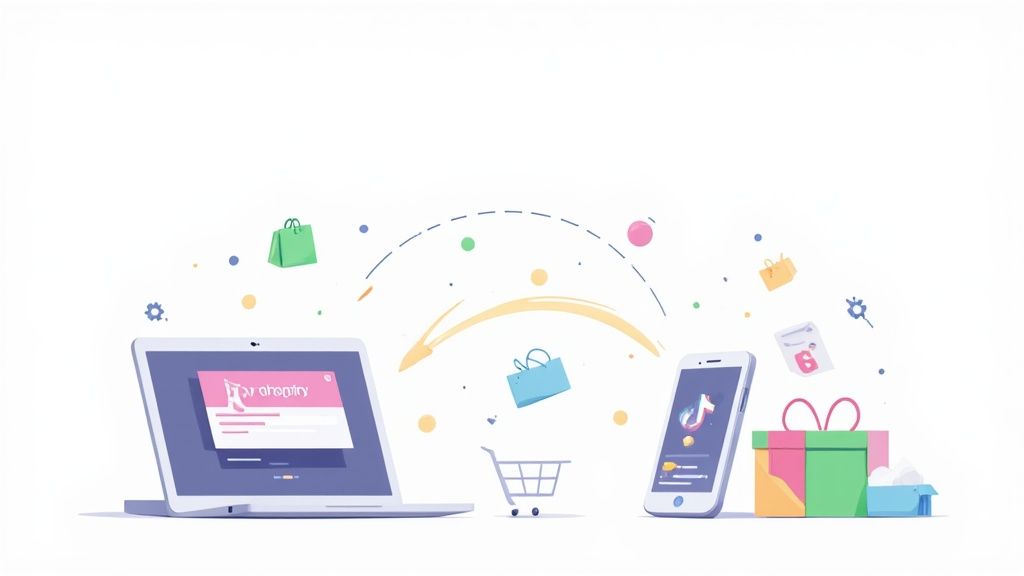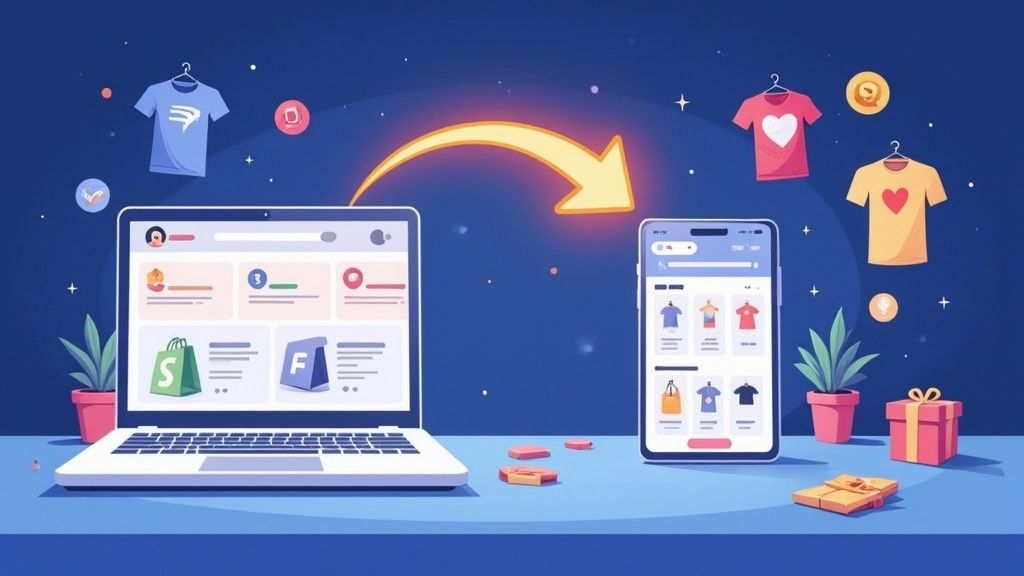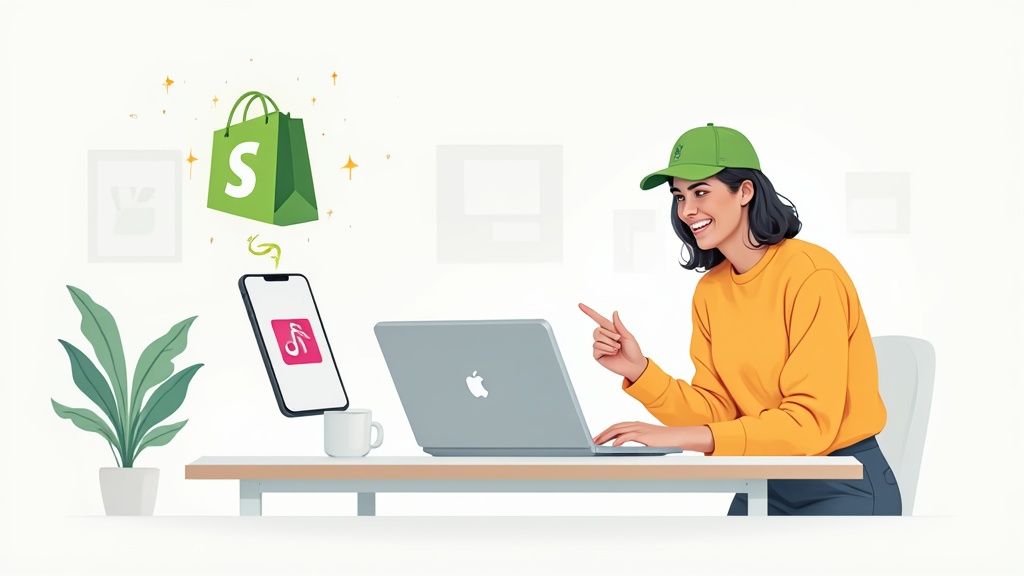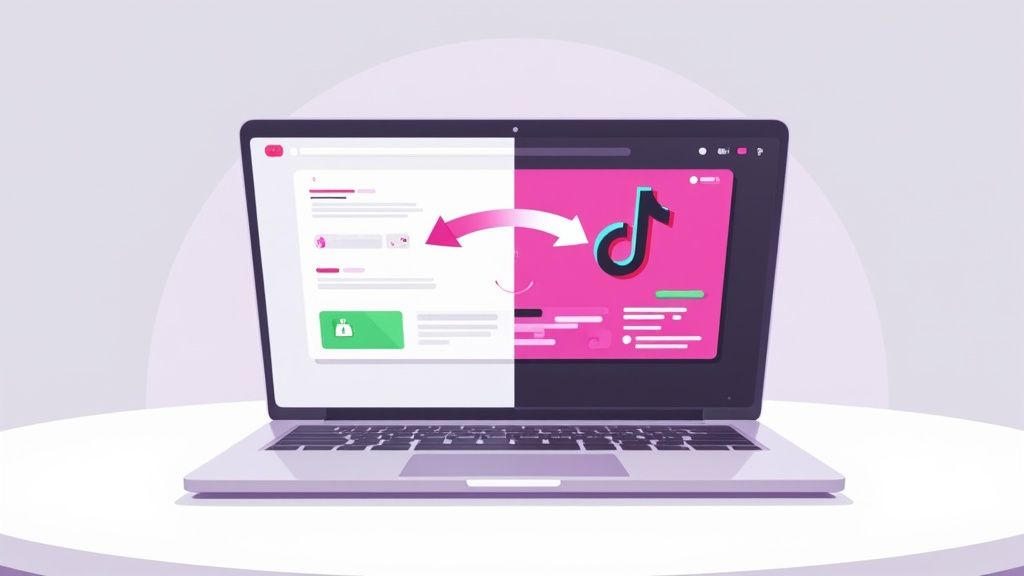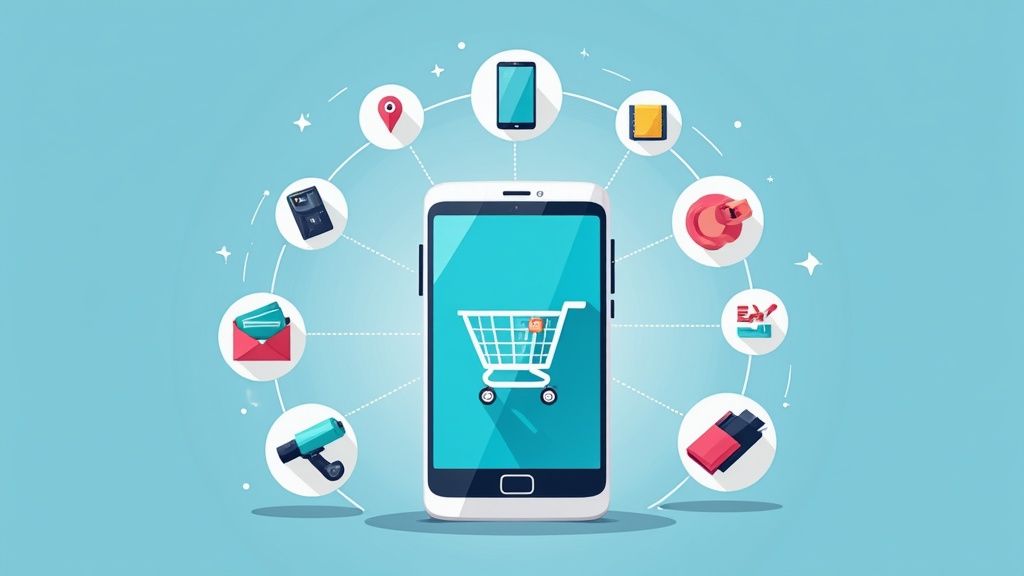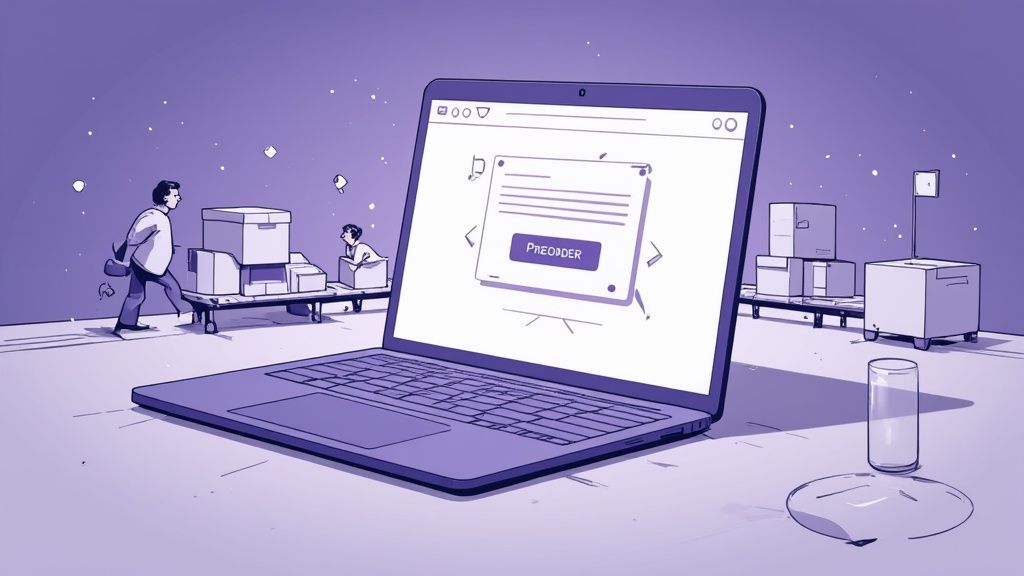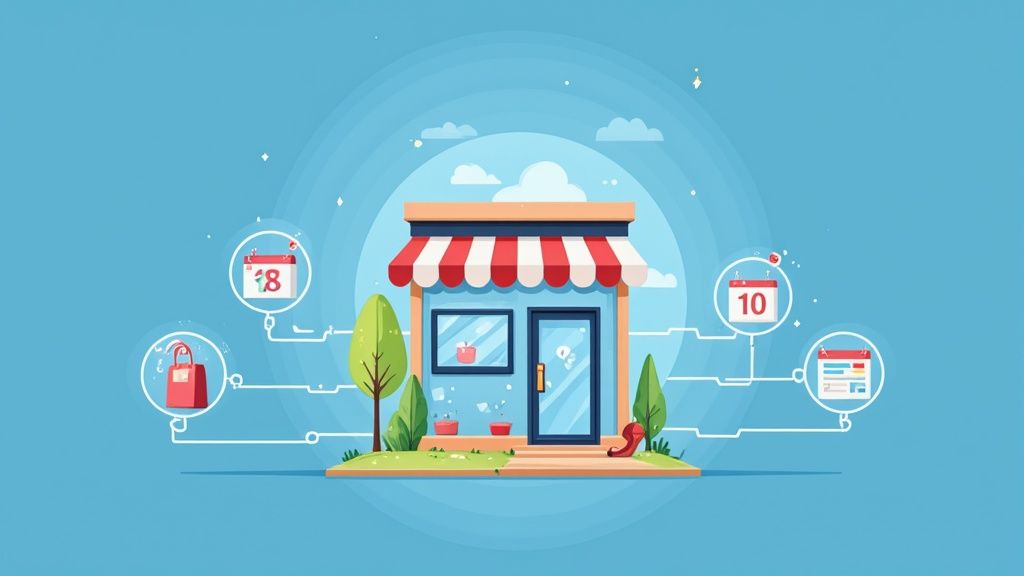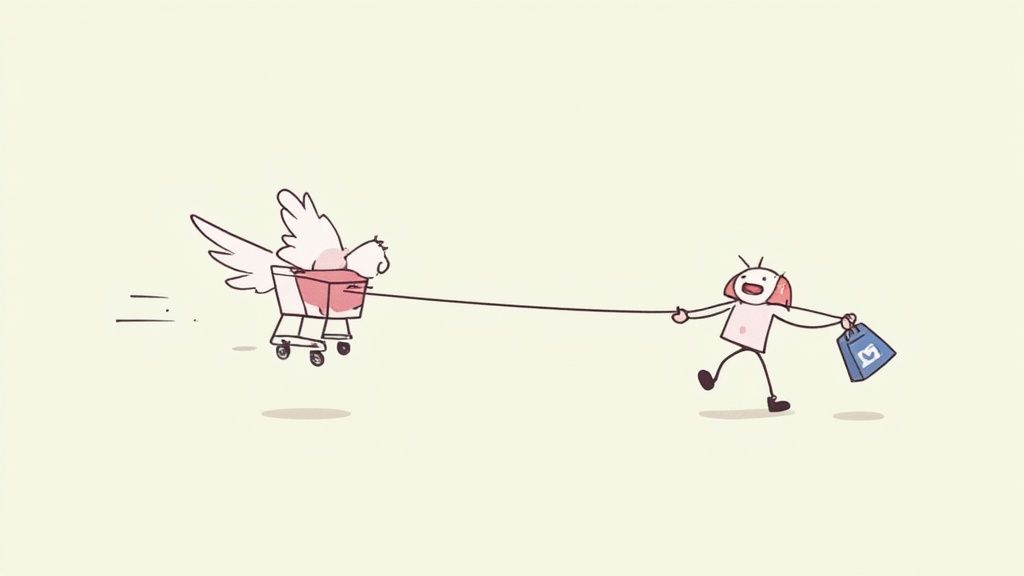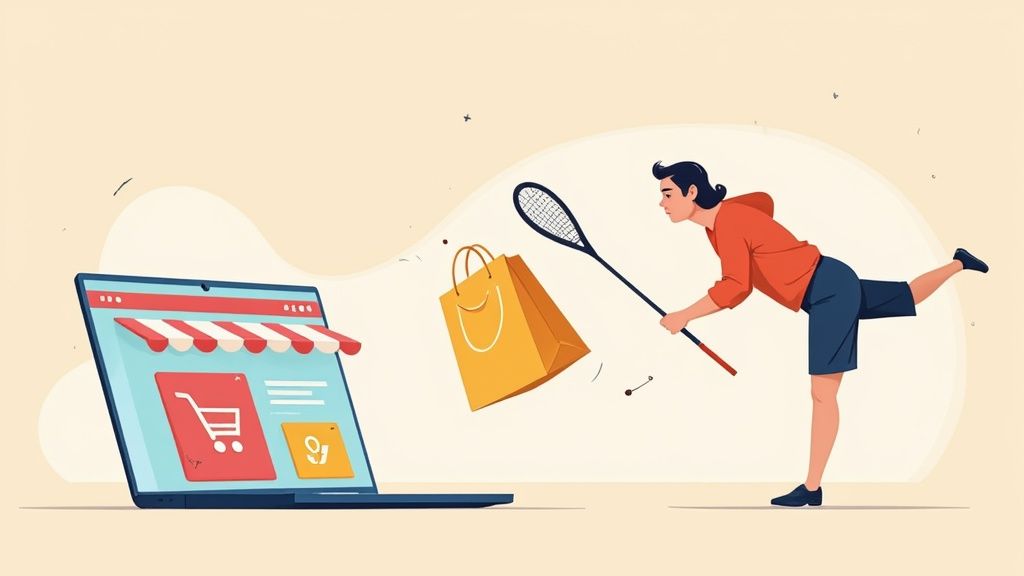
Launching a subscription box is so much more than just shipping products. It's about creating a predictable revenue engine and building a brand people genuinely love by curating fantastic products for a very specific audience. The core idea is to find a profitable niche, source unique items, and then build an e-commerce platform that can handle the recurring payments and shipping.
Think of it as creating a repeatable "wow" experience that lands on your customer's doorstep every month.
Your Blueprint for a Successful Subscription Box

Before you spend a single dollar on products or fancy packaging, you need a rock-solid strategy. This isn’t just about shipping nice things; it’s about building a sustainable business from the ground up.
The first, most critical question you have to answer is whether your idea is actually viable in today's competitive market. Honestly, success really hinges on finding an underserved audience and giving them an experience they can't get anywhere else. This guide is your complete playbook, designed to walk you through every stage—from validating your concept to delighting your very first paying subscribers.
Understanding the Market and Models
The subscription e-commerce space is absolutely booming. The global market, currently valued at around $36 billion, is projected to climb to $41.79 billion in the next year alone. That momentum isn’t slowing down, either. Forecasts predict the market will more than double to a staggering $87.06 billion within five years, all driven by consumer demand for personalized and convenient shopping. You can discover more insights about the subscription box market growth to see the full picture.
This incredible growth spells opportunity, but it also means you need the right business model to stand out. Your choice of model will dictate everything from your approach to curation and pricing to how you build customer relationships.
Key Takeaway: The foundation of a great subscription box isn't just the products inside—it's the business model you choose. Your model determines how you create value, manage inventory, and ultimately build long-term customer loyalty.
To get started, you'll need to decide which subscription model best fits your idea. Each has its own strengths and challenges, so picking the right one is crucial for setting your business up for success.
Choosing Your Subscription Box Model
Here’s a breakdown of the core business models to help you decide which approach fits your vision and niche.
By understanding where the market is headed and carefully selecting the right model for your vision, you establish a clear path forward. This initial blueprint ensures that every decision you make down the line—from product sourcing to your Shopify store setup—is aligned with a coherent and profitable plan.
Finding a Niche and Sourcing Standout Products

Before you think about boxes or shipping, you need to nail down your niche. This is the absolute soul of your subscription box. It’s what guides every single choice, from the products you pick to the way you talk to your customers.
Don't just aim for "beauty" or "snacks." That's way too broad. Real success in this game comes from finding a specific, underserved micro-niche—a passionate community just waiting for a box that truly gets them. This isn't about a lucky guess; it's about doing some smart detective work.
Identifying a Profitable Micro-Niche
Think of yourself as a digital anthropologist. Your job is to find your corner of the market by listening in on the online spaces where your ideal customers already hang out.
- Social Media Deep Dives: Go beyond a quick search. Hunt for hashtags on Instagram and TikTok related to your general idea. What are people getting excited about? What can't they find? Pay attention to the comments.
- Forum and Community Analysis: Reddit subs, Facebook Groups, and niche forums are goldmines. A hyper-engaged group of 5,000 "vegan rock climbers" is a much stronger target than a million generic "outdoor enthusiasts."
- Competitor Gap Analysis: Size up the existing players. If you see five general "dog boxes," maybe there's an opening for a box just for small-breed dogs with sensitive skin. What are they missing?
This groundwork helps you form a solid hypothesis. Once you have it, you need to validate that people are actually searching for the kinds of solutions you can provide. This is how you confirm you’re building for a real, paying audience, not just for yourself.
The opportunity here is undeniable. The global subscription box market was valued at $38.4 billion and is projected to hit $44.31 billion in the next year. Looking further out, experts predict it will surge to around $185.6 billion within a decade. It shows just how much potential there is if you can carve out your unique space.
Mastering the Art of Product Sourcing
With your niche locked in, the real fun begins: finding the products that will make your subscribers feel seen and delighted every month. Sourcing isn’t just about filling a box. It’s about curation, storytelling, and creating an unboxing experience they can’t wait to share.
Your strategy will likely be a mix of working with wholesale suppliers and building direct relationships with smaller, independent brands. For a deeper dive into the business model, check out our guide on subscription e-commerce fundamentals.
A truly memorable subscription box is a carefully balanced act. It combines a high-value 'hero' item with several smaller 'discovery' products. The hero item justifies the price, while the discovery items create excitement and introduce subscribers to new favorites.
Let’s say you're launching a "Mindful Morning" box. Here’s how you might approach sourcing:
- The Hero Item: Partner with a small-batch coffee roaster for a full-sized bag of single-origin beans. This is the anchor that communicates your box's value.
- Discovery Products: Then, you could add a unique artisanal mug from an Etsy maker, a guided meditation journal from a small publisher, and gourmet biscotti from a local baker.
This combination of perceived value and the thrill of discovery is what keeps subscribers coming back for more.
Strategies for Finding Reliable Partners
Finding the right suppliers is make-or-break for your box's quality and consistency. You need partners who get the subscription model and can grow with you.
Effective Sourcing Channels
Ultimately, building strong relationships is your greatest asset. When you find a brand you love, treat them like a true partner. Feature them on social media, tell their story in your box inserts, and give them valuable feedback. That goodwill can translate into better pricing, exclusive products, and a rock-solid supply chain as you scale. This curated, relationship-driven approach is what separates a good box from a great one.
Setting Up Your Financials and Pricing for Profit
Profit in the subscription world is made or lost in the spreadsheet. Seriously. Before you even think about marketing, you need total confidence in your numbers to build a business that will last. So many new entrepreneurs get this wrong, focusing only on the sexy product costs and completely forgetting the small expenses that silently eat away at profitability.
This is your no-nonsense guide to building a financial foundation. The goal? To make sure you not only cover every single cost but also lock in a healthy profit margin from your very first subscriber.
Calculating Your True Cost of Goods Sold
Your Cost of Goods Sold (COGS) is the direct, all-in cost of every single box you ship. Getting this number right is the most critical part of creating a subscription box that can actually make you money. It's so much more than the wholesale price of the items inside; it's a complete tally of every little thing.
Your COGS calculation absolutely must include:
- Product Costs: The wholesale price you pay for each item going in the box.
- Packaging Costs: This covers the custom box itself, crinkle paper, filler, tape, and any stickers or printed inserts.
- Shipping Materials: The mailer bag or outer box, plus the shipping label.
- Transaction Fees: Payment processors like Shopify Payments or PayPal take a cut of every sale (usually around 2.9% + 30¢).
Forgetting even one of these can lead to underpricing, which is one of the fastest ways for a new subscription business to go under. You have to account for every single penny spent to deliver that unboxing experience.
A classic mistake is underestimating packaging and fulfillment costs. That fancy crinkle paper and custom tissue paper add up fast. You need to price them out per box, not just as a bulk purchase, to see their true impact on your margins.
This image breaks down how the costs typically stack up for a subscription box, showing where your money is really going.

As you can see, sourcing your products is the biggest piece of the pie, but packaging and shipping combined are a huge chunk of your total cost. Never overlook them.
Crafting a Profitable Pricing Strategy
Once you have your COGS dialed in, you can build a pricing strategy that actually guarantees you’ll make money. A solid rule of thumb in the subscription industry is to aim for a profit margin between 40% and 60%. This gives you enough breathing room to cover marketing, overhead, and eventually, your own salary.
Let’s walk through a quick, real-world scenario. Imagine your total COGS per box comes out to $22.
- Set Your Target Price: To hit a 50% margin, you’d need to price your box at $44. (The math is: $22 COGS / (1 - 0.50 margin) = $44).
- Scope Out the Competition: How does a $44 price point look next to similar boxes in your niche? If you're significantly higher, you better be sure your box's perceived value justifies that price.
- Think About Customer Perception: Does the price feel like a steal? The perceived value of the items inside should be way higher than what the customer pays. A box priced at $44 should feel like it contains products with a total retail value of $70 or more.
This is where you need to start thinking about the tech side. To properly manage all your subscription cycles and automate payments, finding the right tool is a game-changer. A system that can handle different billing schedules and promotions is essential. You can find a helpful list of the best recurring billing software options to see what’s out there.
To help you get granular with your own numbers, here’s a simple cost breakdown you can use as a template.
Example Cost Breakdown for a Single Box
Use this sample cost breakdown to accurately calculate your own pricing and ensure profitability from day one.
Don't guess on these numbers. Get real quotes from suppliers for every single item to build an accurate financial model.
Structuring Your Offers and Promotions
With your core price locked in, you can get creative with your offers. Monthly plans are the standard, but offering longer-term plans can be a massive boost to your cash flow and customer lifetime value.
- Quarterly Plans: Offer a small discount, maybe 5-10% off, for customers who prepay for three months. This secures revenue upfront and increases loyalty.
- Annual Plans: Give a significant discount, like 15-20% off, for a full year. This is a powerful way to lock in your most dedicated fans.
When it comes to launch promotions, be strategic. Instead of a simple dollar-off discount that cheapens your brand, consider offering a "free gift with your first box." This adds a ton of value without devaluing your core product, setting a strong brand precedent right from the start.
Building Your E-Commerce Store and Tech Stack

Alright, you've got your financials mapped out. Now it’s time to build the digital home for your subscription box. Let's be clear: your website is much more than just a place to take orders. It’s your 24/7 salesperson, brand ambassador, and customer service hub all rolled into one.
Getting this part right creates an engine for growth. But if you get it wrong, even the most amazing products will struggle to find an audience.
For almost every modern e-commerce brand dipping its toes into recurring revenue, Shopify is the undisputed king. It hits that sweet spot of being incredibly user-friendly while also having the power to scale with you. The catch? A standard Shopify store isn't built for subscriptions right out of the box. You'll need to assemble the right tech stack to handle the unique demands of this business model.
Choosing Your Core E-Commerce Platform
The platform you choose is the backbone of your entire operation. While there are plenty of options out there, the goal is to pick one that simplifies your life, not complicates it. You need something that can grow with you and doesn't require a team of developers just to keep the lights on.
This is exactly where Shopify shines. It’s built for entrepreneurs who need to focus on their product and marketing, not on server maintenance. The massive app ecosystem means you can bolt on specialized functionality as you grow, which is non-negotiable for a subscription box.
Your website really only has two jobs: sell the experience of your box and make it ridiculously simple for someone to become a subscriber. That means nailing your messaging, using high-quality visuals, and designing a user journey that feels natural from the very first click.
Assembling Your Subscription Tech Stack
A subscription business runs on recurring payments, and that calls for specialized software. This is not the place to cut corners. Your subscription management app is the single most critical piece of your tech stack. It's the engine that automates your billing, manages customer accounts, and gives you the tools to fight churn.
Think of it as the central nervous system for your recurring revenue. A few of the most reliable and popular choices that integrate seamlessly with Shopify include:
- Recharge: Often seen as the industry standard, Recharge is incredibly powerful and built to scale, offering robust features and sophisticated customer portals.
- Awtomic: Known for its slick interface and focus on building bundles and customized subscription experiences, Awtomic gives you a ton of flexibility in how you structure your offers.
- Bold Subscriptions: Another major player in the space, Bold offers a comprehensive feature set and is well-regarded for its strong developer tools and customization capabilities.
When you're looking at these apps, remember you're not just buying software. You're investing in your customer's experience. The whole point is to make it effortless for subscribers to manage their own accounts—skipping a month, swapping a product, or updating their payment info—without ever having to send you an email.
Pro Tip: A smooth, self-service customer portal is your secret weapon for retention. When customers feel in control and can easily manage their own subscription, it dramatically cuts down on cancellations that happen because of minor frustrations.
Designing Pages That Convert Visitors to Subscribers
Once your tech is sorted out, it's all about persuasion. Your product page isn't just selling a single item; it's a sales page for an ongoing relationship.
You have to sell the dream, not just the contents. Instead of a boring list of products, use your words and images to tell the story of the experience your box delivers. Is it a quiet moment of self-care? A fun family activity? A journey of culinary discovery? You have to show them, not just tell them.
Finally, be absolutely ruthless about streamlining your checkout process. Every extra field, every unnecessary click, is a place where you can lose a customer. The path from "I want this" to "I'm a subscriber" needs to be as short and frictionless as possible. A clean, mobile-friendly checkout that inspires trust is non-negotiable if you're serious about building a subscription box that lasts.
Mastering Packaging, Shipping, and Fulfillment
You’ve nailed the digital side of your business, but now comes the real-world challenge: getting your carefully curated products into your subscribers' hands. This is where the unboxing experience truly begins, and it's also where logistics can get messy, fast.
Packaging and fulfillment are the unsung heroes of a great subscription service. Get it right, and you create a seamless, memorable moment for your customer. Get it wrong, and you’re looking at damaged goods, shipping nightmares, and unhappy subscribers. Let’s walk through how to do this the right way.
Designing Branded Packaging That Delights
Your box is the first physical handshake a subscriber has with your brand. It’s so much more than a simple container; it's a powerful marketing tool that lands directly on their doorstep. The unboxing experience—that tactile, visual journey of opening the box—is a huge driver of customer joy and, importantly, social media shares.
But don't worry, creating custom-branded packaging doesn't have to decimate your budget. You can start smart and scale up.
- Printed Mailer Boxes: These are the gold standard for a premium feel. Getting them printed with your logo and brand colors makes a serious first impression.
- Custom Stickers or Tape: A more budget-friendly route is to buy standard kraft or white boxes and give them a branded touch with custom-designed stickers or packing tape. It's surprisingly effective.
- Printed Inserts: Never underestimate the power of a simple, high-quality "thank you" card or an insert that tells the story behind the products. It adds a personal touch that elevates the entire experience.
Remember, your packaging has to be both beautiful and tough. Always order samples and test them yourself. A great pro tip is to pack a prototype box and mail it to a friend across the country to see exactly how it holds up in transit. Product integrity is non-negotiable.
Key Insight: The unboxing experience is a shareable moment. A well-designed box not only protects your products but also encourages user-generated content, turning your customers into your most effective marketers.
This is also a fantastic opportunity to think about how you present items inside the box. Grouping products together thematically can create a more cohesive feel. You can learn more about how Shopify product bundles can transform store revenue and apply those same principles to your box curation for a bigger impact.
Navigating the Complexities of Shipping
Shipping is, without a doubt, the most underestimated cost for new subscription box entrepreneurs. If you miscalculate your rates, you can wipe out your profit margins before you even know what happened.
Your goal is to strike a delicate balance between cost-effectiveness and reliability. The major carriers each have their own sweet spots:
- USPS (United States Postal Service): This is often your most affordable bet for lightweight packages, especially those under 13 oz that can ship via First-Class Mail. Their Priority Mail flat-rate boxes are also a lifesaver for predictable, cost-effective shipping.
- UPS & FedEx: These carriers really shine with heavier packages. They typically offer more detailed tracking and guaranteed delivery dates, which can be crucial if you're shipping higher-value boxes.
Jill Lodato, the founder of Kids Baking Club, shared a crucial piece of advice with us: "In the U.S., boxes 13 oz and under ship first class. Anything over 13 oz will add another $3 to the base price. If you can strategically optimize your packaging to weigh 13 oz or less, the savings will add up quickly!"
The Big Decision: In-House vs. Outsourced Fulfillment
When you're just starting out, you'll probably be packing boxes from your living room floor. That's totally normal. This hands-on approach gives you total quality control and an intimate understanding of the process. But as you grow, you'll hit a fork in the road: keep fulfillment in-house or outsource it to a third-party logistics (3PL) provider?
Handing over your fulfillment to a 3PL is a major step. It means trusting an outside partner with a critical piece of your customer experience. As Ryan Culver, founder of Platterful, points out, "Outsourcing your fulfillment to an experienced external provider...can also give you access to a relationship with a postal consolidator – which can save you $1-4 per package." That kind of savings can often justify the 3PL's fees all on its own.
Ultimately, the right choice boils down to your order volume, your budget, and how much you value your own time. Getting your logistics running smoothly is what will allow you to build a subscription box that can truly grow and thrive.
Launching Your Box and Acquiring Subscribers
You’ve sourced your products and your tech stack is humming. Now it's time to switch gears from building to selling. All that careful planning is about to pay off. A successful debut isn’t about just flipping a switch and hoping for the best; it's about building real momentum and creating a wave of excitement that pulls in your first loyal subscribers.
Think of this as your go-to-market playbook. It all starts with a smart pre-launch campaign designed to make sure you have sales waiting for you on day one.
Building Pre-Launch Buzz and a Waitlist
Your launch really begins weeks before you ever process a single payment. The whole point of a pre-launch campaign is to gather an audience of eager, potential customers who are ready to click "buy" the second you go live. This isn't just about creating hype; it's about validating your idea and locking in those crucial initial sales.
First up, create a simple but beautiful "coming soon" landing page. This page needs to capture the very essence of your box, show off some stunning photos of your prototype, and have one crystal-clear call to action: an email sign-up form for your waitlist. Trust me, this list will be your most valuable asset before you launch.
Once that page is live, all your marketing efforts should point directly to it.
- Social Media Teasers: Start dropping hints and behind-the-scenes glimpses on platforms like Instagram and TikTok. Show off sneak peeks of products, your unboxing experience, or share the story behind one of your brand partners.
- Influencer Outreach: Find micro-influencers who are a perfect fit for your niche. Send them a free prototype box in exchange for an honest unboxing video or a post they can share with their followers during your pre-launch window.
- Engage in Communities: Don't just spam links. Genuinely participate in the Reddit and Facebook groups where your ideal customers actually spend their time. Share your journey, ask for feedback, and invite people to join your waitlist for an exclusive launch-day offer.
Make sure you nurture that email list with weekly updates. Make these people feel like insiders. Share your progress, ask for their opinions on product choices, and keep reminding them of the special offer they'll get for being a founding member.
A powerful launch-day promotion for your waitlist isn't just a simple discount. Instead, try offering a high-value "free bonus gift" with their first box. This protects your brand's perceived value while making those early subscribers feel truly special.
The demand for these kinds of curated experiences is massive. The global subscription box industry was valued at $37.5 billion and is projected to skyrocket to $116.2 billion within a decade. This incredible growth is fueled by people's hunger for niche products and the power of social media to build dedicated fan bases—which is exactly what your pre-launch campaign is built to do.
Driving Sustainable Growth Post-Launch
Okay, you've launched and your first batch of boxes are out the door. The game now shifts from a sprint to a marathon. Your focus has to move toward sustainable growth and building a solid foundation for long-term profitability. This is all about refining your marketing and creating a genuine community around your brand.
Paid advertising on platforms like Instagram and Facebook will become a key lever for growth. Use the data from your first subscribers to build lookalike audiences—this means targeting new users who share characteristics with your best customers. As you map out your growth, don't be afraid to explore other sales channels, including looking into strategies for selling on Amazon to tap into an even broader audience.
Content is your engine for organic, free growth. You need to show off your box's unique value by creating content that educates, entertains, and inspires. This could be blog posts about your brand partners, video tutorials using products from the box, or even user-generated content campaigns that encourage subscribers to share their own unboxing moments.
Focusing on Retention: Your Key to Profitability
Here's a hard truth: acquiring a new customer is way more expensive than keeping an existing one. That’s why customer retention is the real secret to a profitable subscription box business. A low churn rate (the percentage of subscribers who cancel) is the ultimate sign of a healthy, sustainable company.
The first step to reducing churn is understanding why it's happening in the first place. Set up a simple cancellation survey that asks subscribers for their reason for leaving. This feedback is absolute gold.
Next, turn your happy subscribers into your best marketers. A simple referral program that rewards both the existing subscriber and their friend with a discount or a free product can be an incredibly effective and low-cost way to get new customers.
Finally, never stop iterating. Use the feedback you gather from surveys and customer service interactions to constantly improve your box. A business that listens to its community and adapts is one that builds the kind of loyalty that lasts for years.
Ready to build a high-converting home for your new subscription box? ECORN specializes in Shopify development and conversion rate optimization to help brands like yours launch and scale. Let's build your store together.






